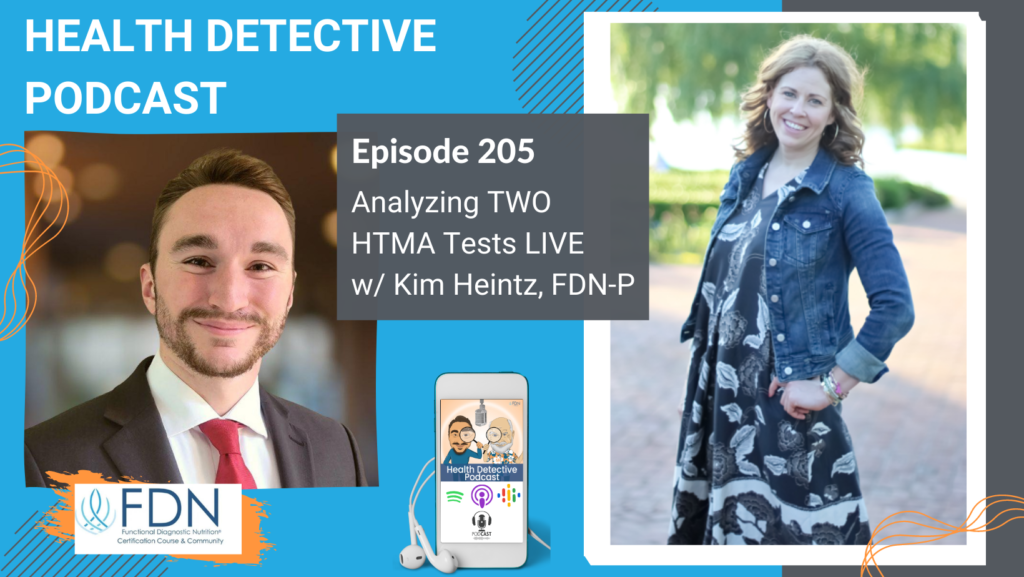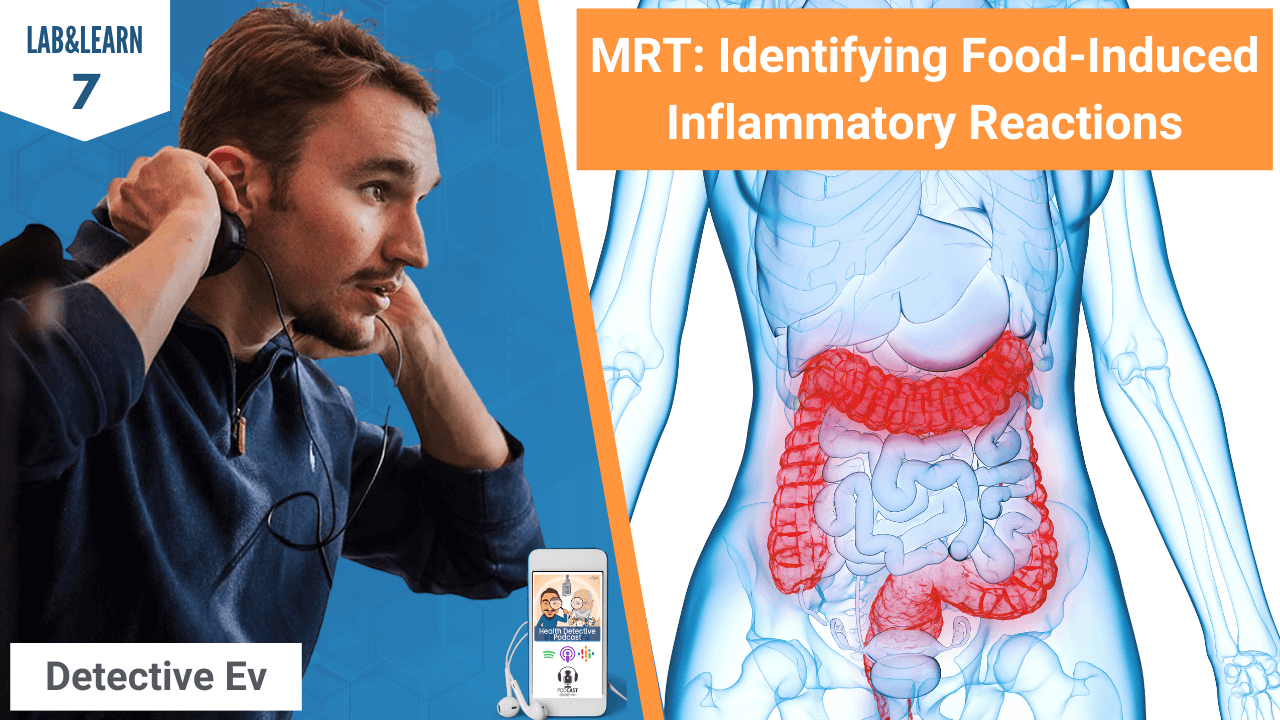Introduction
[00:00:00] Detective Ev: Welcome to the Health Detective Podcast. My name is Evan Transue, AKA Detective Ev. I will be your host for this show where we will be analyzing 2 different HTMA tests. Here is today’s episode.
All right. Hello there, Kim. Welcome to the Health Detective Podcast. How are you?
[00:00:16] Kim Heintz: Hey, thanks so much for having me. I’m doing good. How are you?
[00:00:19] Detective Ev: I’m doing well. So, we have a special circumstance today. Normally, if you listen to the show regularly, you know, when we bring on FDN practitioners, we typically interview them for their story first. But because I posted something in one of our groups, Kim was willing to help me out here and jump right into a lab analysis podcast with me, which you guys have been loving. These are super fun.
Kim, we’ve actually done the HTMA before, but the video didn’t work at all. We didn’t even have the video of the person because they came on and recorded with a phone. We love you, Barbara. Your episode did great for audio, but we need someone that can come on and show these people this stuff on video, on our YouTube as well. We know that people want to hear this and see this, but they weren’t able to fully last time, so I think we’re going to have a good time.

Kim was even cooler. She brought on two different clients for us, two different patterns for the HTMA test, which is hair, tissue, mineral analysis, if you guys do not know. It is not one of the FDN core labs. We don’t teach this in the main course, but it is something that people really enjoy learning about right after graduating FDN.
Learning From HTMA Tests Gurus
We’re blessed to have Kendra Perry, who was not only an FDN, she also used to be the director of the professionals’ group for FDN. She went on to create, I would have to imagine, what is one of the more popular HTMA courses out there in the industry. She’s a total expert. She knows what she’s talking about.

We’re just lucky to have people like her and like you in this space that we can learn from, even if we’ve never used the test ourselves. I’m starting to use it more too. So, I’m excited about this and getting to hear from you today.
This time I’m going to share the entire screen cause I think that’s what might have screwed me up last time. I will get this started here. What we are looking at is an HTMA test by Trace Elements. Last time, even though we couldn’t see it, we were describing a different test by a different lab.
Just please know, most of them test fundamentally for the same thing. From my understanding, there’s some different markers on here, which Kim, I’m sure you can specify that for us when it’s relevant to do so. I’m actually not sure what the differences would be because I’ve always used the other one. But in terms of the core markers, we are looking at the same thing.
If we look at the top here, we see that we have an age 43, female. We don’t know anything else about her. So, can we hear, to the degree that you’re able to share these details, I understand that it’s overall private, but what was this woman going through when she came to you? Why did she want to do testing and Functional Diagnostic Nutrition type of stuff?
FDNs Do Not Treat Test Results Paperwork
[00:02:34] Kim Heintz: That’s a really good question. She was feeling very inflamed. She was fatigued, but she also felt very revved up. She was having a lot of trouble just kind of regulating her energy patterns throughout the day. She had recently explanted and felt like there was some correlation there with some of the symptoms that she was experiencing. She got really sick from her breast implants from having them for 17 years.
She wanted to run the HTMA so we could take a look at her mineral patterns to see if there were some ways to help support her nervous system to see if there were some heavy metals that may have been part of her breast implants and things like.
[00:03:11] Detective Ev: Okay. Thank you.
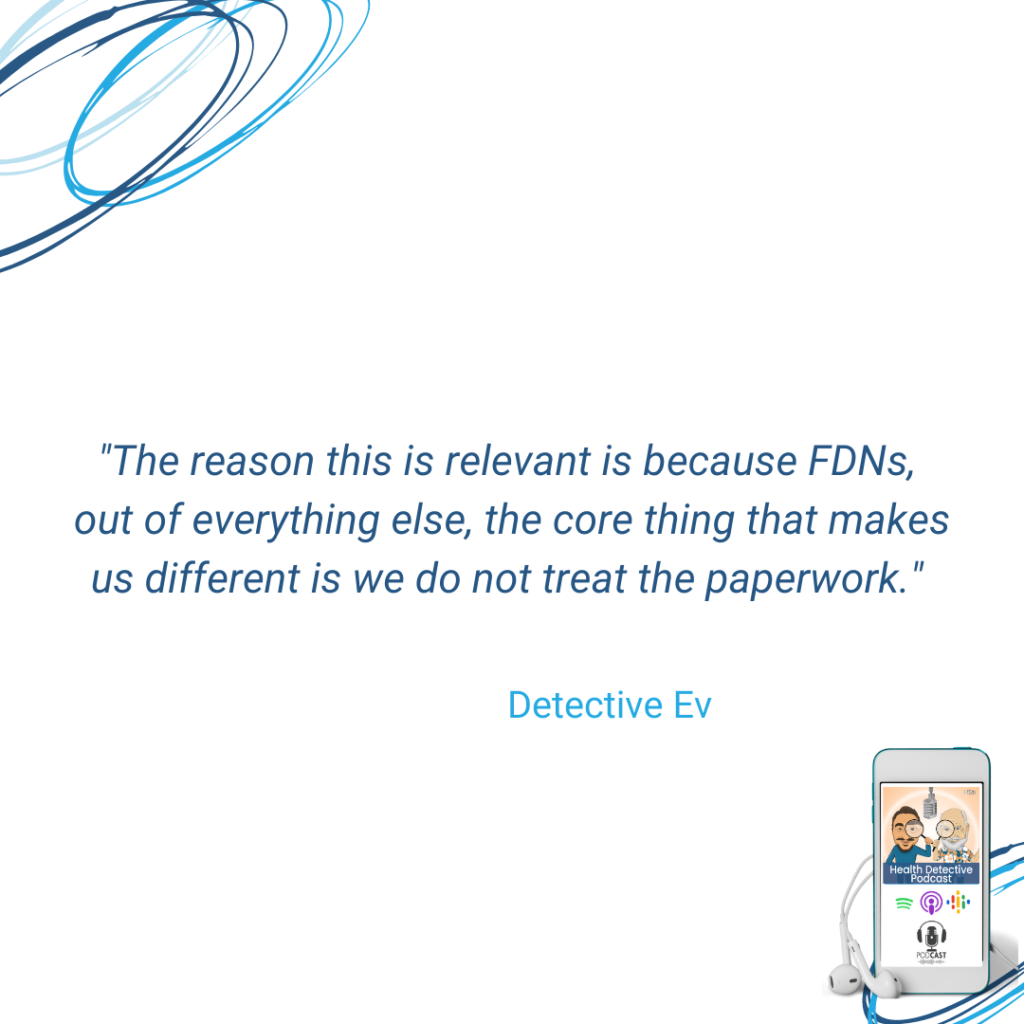
The reason this is relevant is because FDNs, out of everything else, the core thing that makes us different is we do not treat the paperwork. We don’t look at these markers and just automatically say, oh, this is high, or this is low. So, this is what this means. We want to know about the person and we’re clinically correlating the things that we see on the tests to the individual. So that’s something that we’ll reference probably multiple times as we go through these lab results together.
Now, the first section here, the nutritional elements, I’m recognizing this right away, even though I’ve never used this specific test. I’m seeing something very similar to what we see on the front page of the other one. We have the calcium, magnesium, sodium, potassium. I would assume this is all the same regardless of what test you’re using. These are the Big Four over here, right? This is the core things that you’re looking at?
HTMA Tests: Metabolic Type Analysis
[00:03:55] Kim Heintz: Yeah. When I get an HTMA back from the lab, the first things I always look at are the first four minerals, which were just the ones you said calcium, magnesium, sodium, potassium. I also take a look at the ratio between calcium and phosphorus. That actually tells us what kind of pattern somebody has.
If you see in the upper right-hand corner, it says FAST 1 of this test. That’s because her calcium/phosphorus ratio, meaning her calcium number of 31 divided by phosphorus is below 2.6. And that puts somebody into a fast oxidation state. Those are the first two things that I always take a look at.
Somebody who has a pattern like this client where she’s got the lower calcium and magnesium, and then she has the sodium and potassium being elevated and the midline is truly the midline right there on the test for each one of those minerals, that’s a classic fast oxidation pattern.
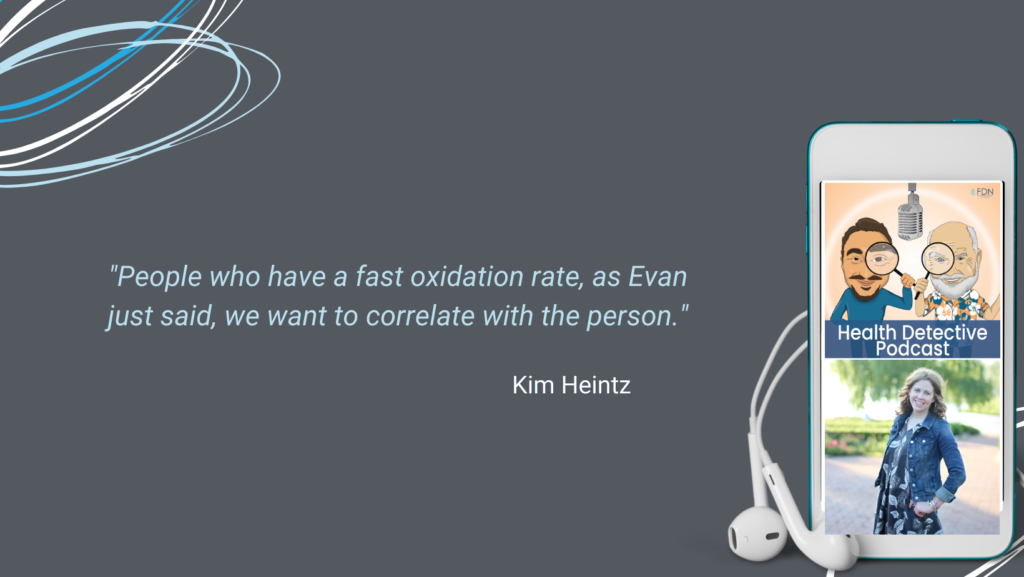
People who have a fast oxidation rate, as Evan just said, we want to correlate with the person. So, somebody who has a fast oxidation state, meaning that lower calcium/magnesium profile, the elevated sodium/potassium profile, and then that fast oxidation, calcium divided by phosphorus, they tend to be more anxious. They tend to be kind of Type A personalities. They feel wired and tired, irritable. They can have like a racing mind sometimes, deal with panic attacks, blood sugar issues, short tempered sometimes. And in longer term, especially because that calcium is low, they can deal with things like osteoporosis, osteoarthritis and things like that.
HTMA Tests: Does the Metabolic Type Shift?
[00:05:26] Detective Ev: One thing I’m curious about. The only other times that I’ve really heard the whole metabolic typing thing is of course with the Metabolic Typing Diet. That’s where I’ve heard it before. I’ve always been labeled a mixed oxidizer on that, which I believe. But what’s interesting is when I finally ran an HTMA, only about barely a year ago, maybe actually a little less, I came up as a slow oxidizer at the time.
Now I ran it because I felt as if I was kind of running myself into the ground. I was wondering if I was depleted. It’s not that I don’t know the health stuff, I knew what I was doing. But I love my work and sometimes it does catch up to me a little bit, right? I’m engaging with it a little too much. I was just wondering if I could course correct so that I could finish out the year strong.
The year for me is the school year, right? Once June comes around, this is golden. You know, I do some podcasting, but I can really take some time off and actually chill. But I’m like, how can I get through this? What can I do? And I was surprised to see the slow oxidizer thing. Because when you hear about slow oxidizers, I don’t really meet the stereotype of it. In fact, what you just described, with the exception of the osteoporosis and stuff, I would’ve met every single one of those symptoms as a kid.
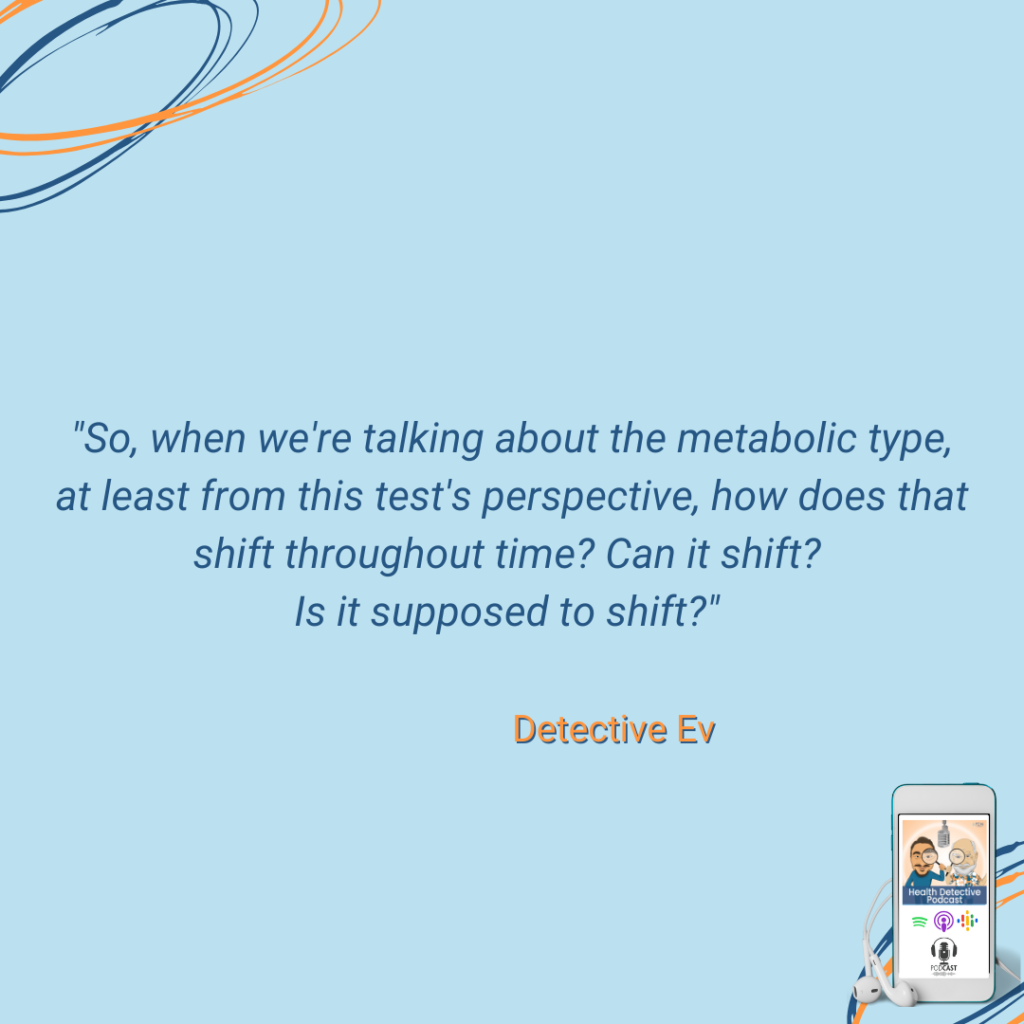
So, when we’re talking about the metabolic type, at least from this test’s perspective, how does that shift throughout time? Can it shift? Is it supposed to shift?
HTMA Tests: Shifting Metabolic Type Back & Forth
[00:06:35] Kim Heintz: Yeah, it definitely does.
I was a slow oxidizer when I started running these labs on myself. And I would say like 70% to 80% of people tend to be slow oxidizers, especially adults, just because over time stress, things kind of slow down a little bit. But I’m now a fast oxidizer.
You are able to shift yourself from a slow oxidation state to a fast oxidation. People can be fast oxidizers and over time shift into slow oxidation. Kids tend to be, by default, they tend to be fast oxidizers. However, I have run these tests on kids and have found that some of them do tend to be more in the slow oxidation rate.
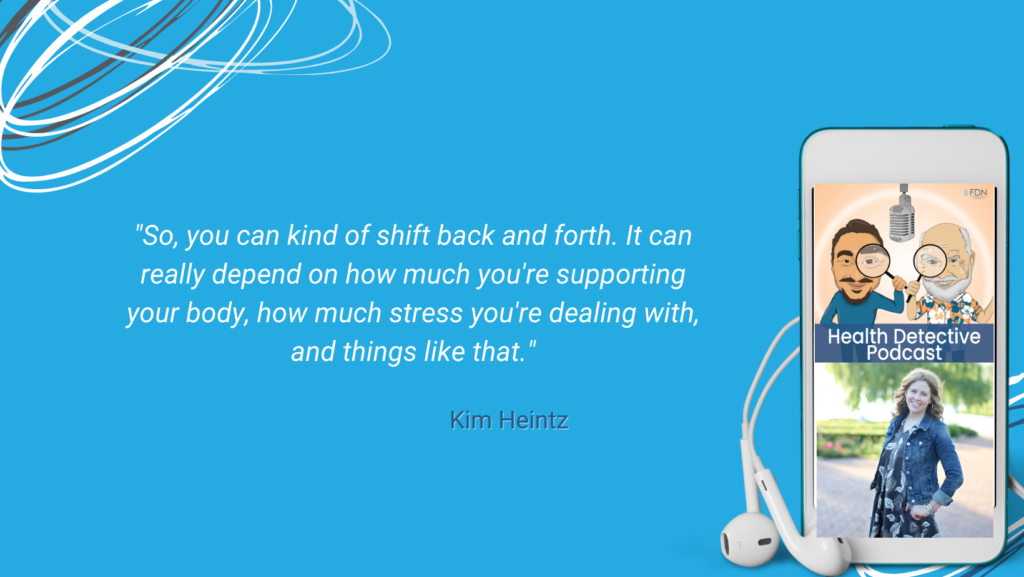
But yeah, you can bounce back and forth. The goal is to get as balanced as possible, right? So, you can kind of shift back and forth. It can really depend on how much you’re supporting your body, how much stress you’re dealing with, and things like that.
[00:07:25] Detective Ev: Okay. I think this is clear, but I should have specified it a little more in the beginning. I’m still an amateur on HTMA, never done any formal training. I’m learning from FDNs. I’ve ran them myself for fun, so I have plenty to learn.
When we are looking at sodium and potassium on the test, literally these things are high. Are these markers that there’s almost like an inverse relationship, that it actually means that it’s low or am I misunderstanding that?
HTMA Tests: Elevated Sodium and the Stress Piece
[00:07:47] Kim Heintz: It definitely can, and we can correlate with how somebody’s feeling and things like that.
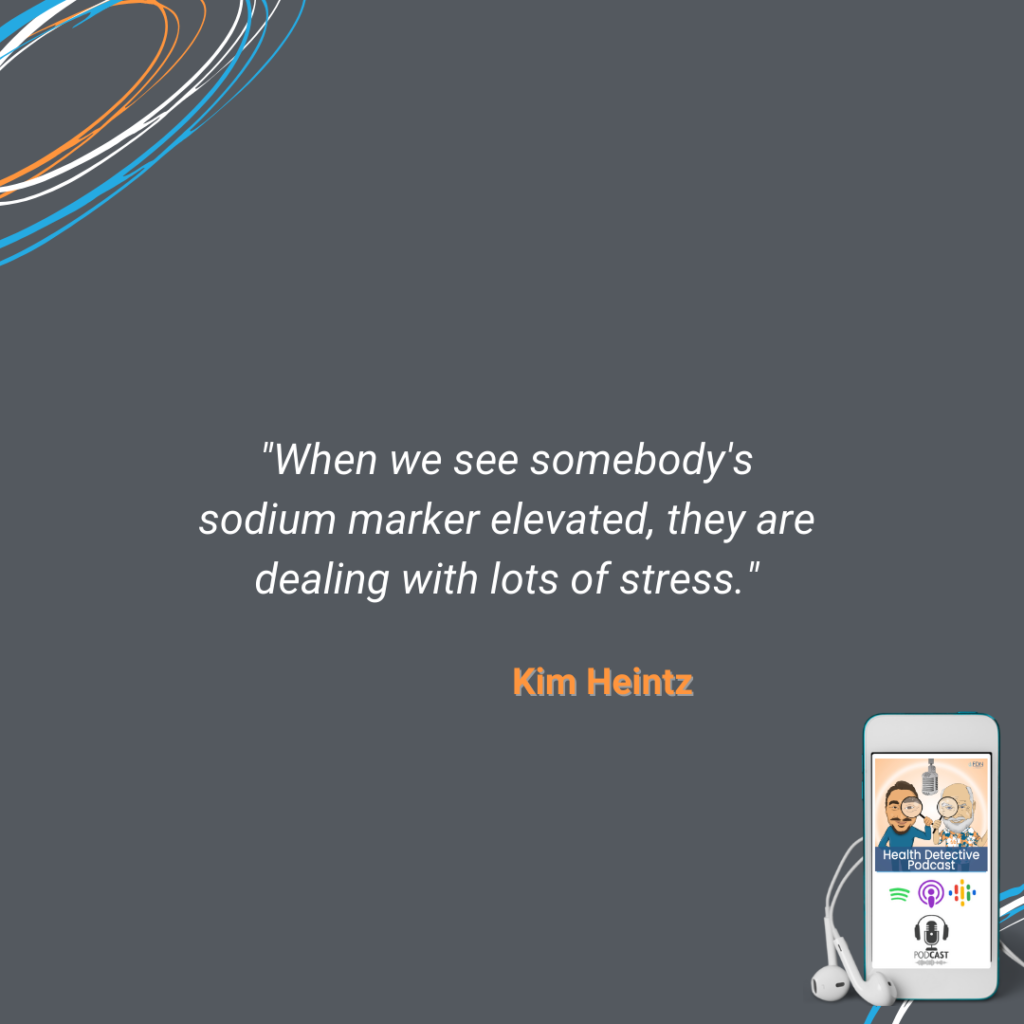
Most of the time elevated sodium on this test does actually mean inflammation in the body. When we see somebody’s sodium marker elevated, they are dealing with lots of stress. It could be gut pathogens; it could be metals. And as you can see over there on the right-hand side in the pink section, she does have some elevated arsenic and mercury and some aluminum. But it could also be other gut infections.
When we see an elevated sodium marker, what we want to do is, one, we really want to help support the nervous system. And two, we want to see where the sources of inflammation are. She came to me feeling inflamed. So, seeing an elevated sodium marker on this test, definitely correlated with how she was feeling.
[00:08:35] Detective Ev: Okay. And for those on audio only, I should have said this as well. Her sodium, this client is as high as it can be, basically. It’s at the very, very upper end of the chart here. What is it that connects high sodium with inflammation? Why does that happen?
[00:08:50] Kim Heintz: It just drives it up. Sodium gets driven up by metals, stress, anger, things like that. It can elevate sodium in the body. But just basically indicates the stress response is greatly increased.
It doesn’t necessarily mean that they’re taking in too much sodium. Sometimes we still want to like, make sure that they’re getting enough sodium into their diet. We don’t necessarily like to supplement with that, but making sure that they’re still getting some sodium, you know, putting Celtic Sea salt on their food and things like that.
HTMA Tests: First Four, Big Four, First Level Minerals
[00:09:17] Detective Ev: Cool. Now I always know those to be the Big Four. I just counted and it looks like there’s another 11 markers in this Nutritional Element section.
I’ve heard in the past and they specified to me that they were oversimplifying it because sometimes there is certain things that you would do about these markers. But generally speaking, if there are even somewhat within range, as from my understanding, it turns out if you get the other four, like the Big Four under control, the others should kind of level out themselves. Is that the case and understanding in this particular client’s results? Like, are you just kind of letting them go as they will, or do you have to do something specific for these?
And for those listening on audio I mean everything technically outta these other 11 markers is within the reference range. It’s just some are higher, some are lower. So, what do we do about that?
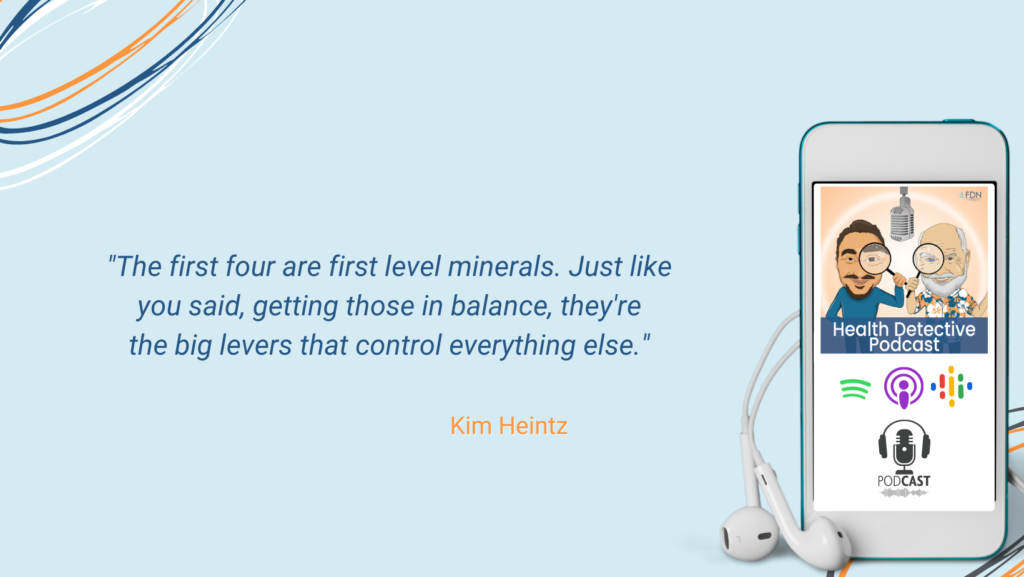
[00:10:02] Kim Heintz: Yeah, that’s a really good question. When we look at all of the minerals in this Nutritional Elements section, we prioritize them. The first four are first level minerals. Just like you said, getting those in balance, they’re the big levers that control everything else. So, if we can get those in balance, a lot of times we’ll see the second level minerals, which be things like copper, zinc, phosphorus, selenium, boron, lithium, we’ll see some of those start to balance out. Then same thing with the third level minerals, which are all the rest of them. They’re at a much lower amount.
HTMA Tests: Occasional Support for that Core Goal
Sometimes we do supplement with some of them. Minerals are a system. We don’t typically try to spot treat minerals because in order to absorb magnesium you need things like boron. That’s why we test boron. Even though boron is a second level mineral, I, a lot of times, will still include a little bit of elemental boron in a protocol because it’s going to help somebody boost their magnesium levels.
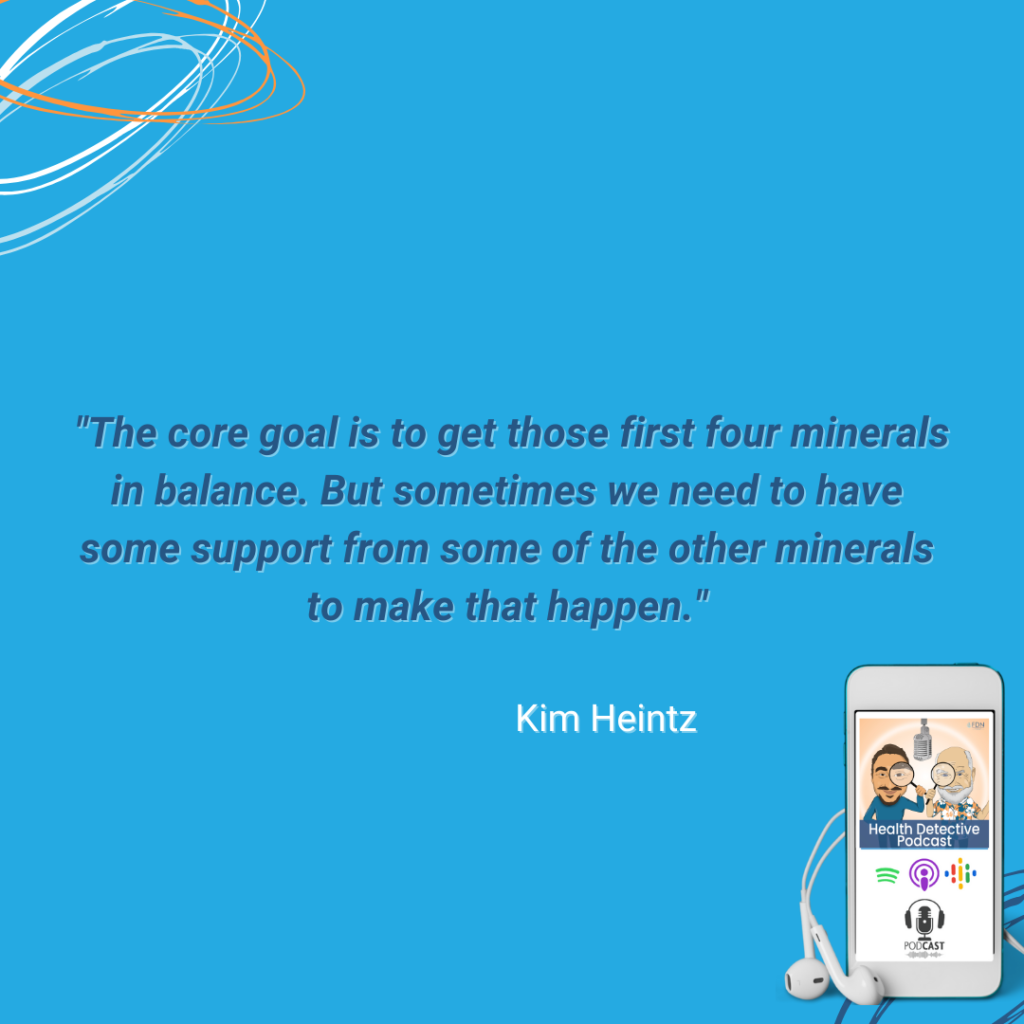
The core goal is to get those first four minerals in balance. But sometimes we need to have some support from some of the other minerals to make that happen.
[00:10:58] Detective Ev: Cool. The last question I have about this section then at this moment is these electrolyte supplements that we see on the market.
Listen, when I’ve used electrolyte supplements, generally speaking, they’ve worked very well. It’s so funny. When you get into this world, I’m sure you’ve experienced this in your own way. When you get into the world of the functional medicine thing, you could get so technical on like one end and then just miss something so fundamental.
I never used electrolytes as a supplement probably until like a year and a half ago. I was doing keto. I was doing all these things and never thought of the benefit of that. It’s like, go figure. I have seen a lot of benefit from it. But I’m thinking about this already, especially when you talk about this synergistic kind of relationship that these minerals will have with one another.
Utilize HTMA Tests to “Test Not Guess”
Then I know that a lot of these electrolyte supplements on the market, they’re straight up one size fits all. I’m not going to mention any brands because I’m not saying that the particular brand is bad per se. But there’s certain popular ones out there that have like a thousand milligrams almost of salt, and then relatively low potassium and magnesium. It doesn’t account for these other things.
What is your take on that? Should people be using those supplements, or would they just be better off running an HTMA and then getting what is more or less a specialized electrolyte supplement? Or do you think those have application?
[00:12:09] Kim Heintz: I think they do have applications. I’m an athlete and I do use electrolyte supplements, especially either before workout, after workout, even during a workout. I’ll find some great benefit from using electrolytes because we’re burning up our minerals when we’re putting our body under a stress like that. I do see value in them.
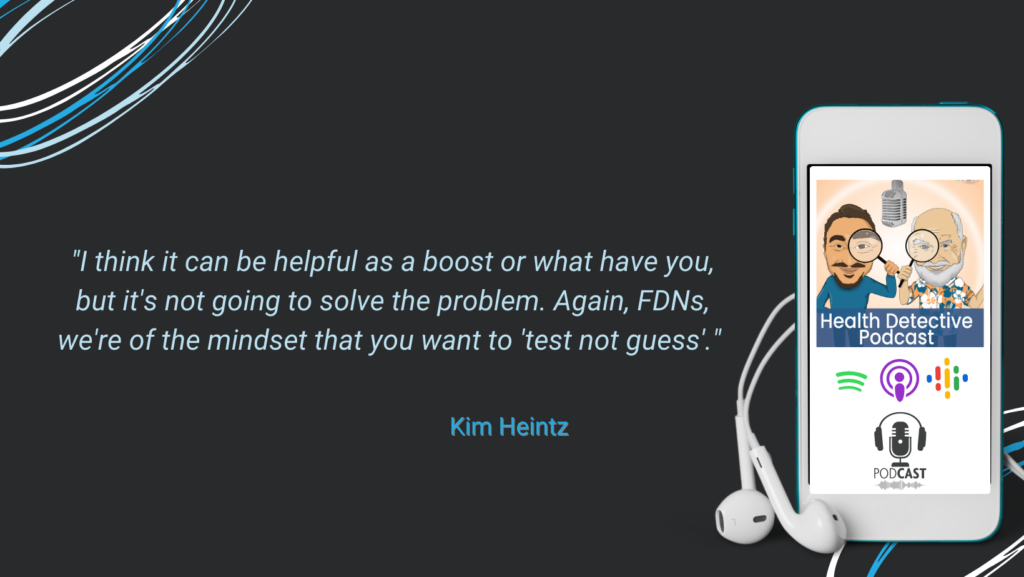
But you know, the configuration that you just shared, which had like sodium, potassium, and magnesium, yeah, that’s great. I think it can be helpful as a boost or what have you, but it’s not going to solve the problem. Again, FDNs, we’re of the mindset that you want to “test not guess”.
So, I do think everybody should run the HTMA. Just, minerals are so responsive to stress. If somebody’s dealing with things like energy issues, sleep issues, all sorts of thyroid issues their minerals are involved in every system of the body. They make the body work better.
HTMA Tests: Toxic Elements
I like to think of them as like the spark plugs of the body. Or sometimes I even talk about they’re like the lubricant that makes the machine run better. So, finding out what your unique patterns are is going to be your best bet because you’re not just trying to guess or trying something and helping that it works.
Just like we talked about, making sure that we’ve got all the key players in place to make sure your unique mineral patterns are being supported the way that they can is going to be your best bet.
[00:13:22] Detective Ev: Thank you.
Next section here on the right is going to be Toxic Elements. It looks like our standard metals here. For those on audio, we have arsenic just above the reference range. Mercury, fair enough over the reference range. And then aluminum within the reference range.
But I also know that some would argue that we really don’t want to see certain metals. How do you interpret a section like this when you see these specific results, Kim?
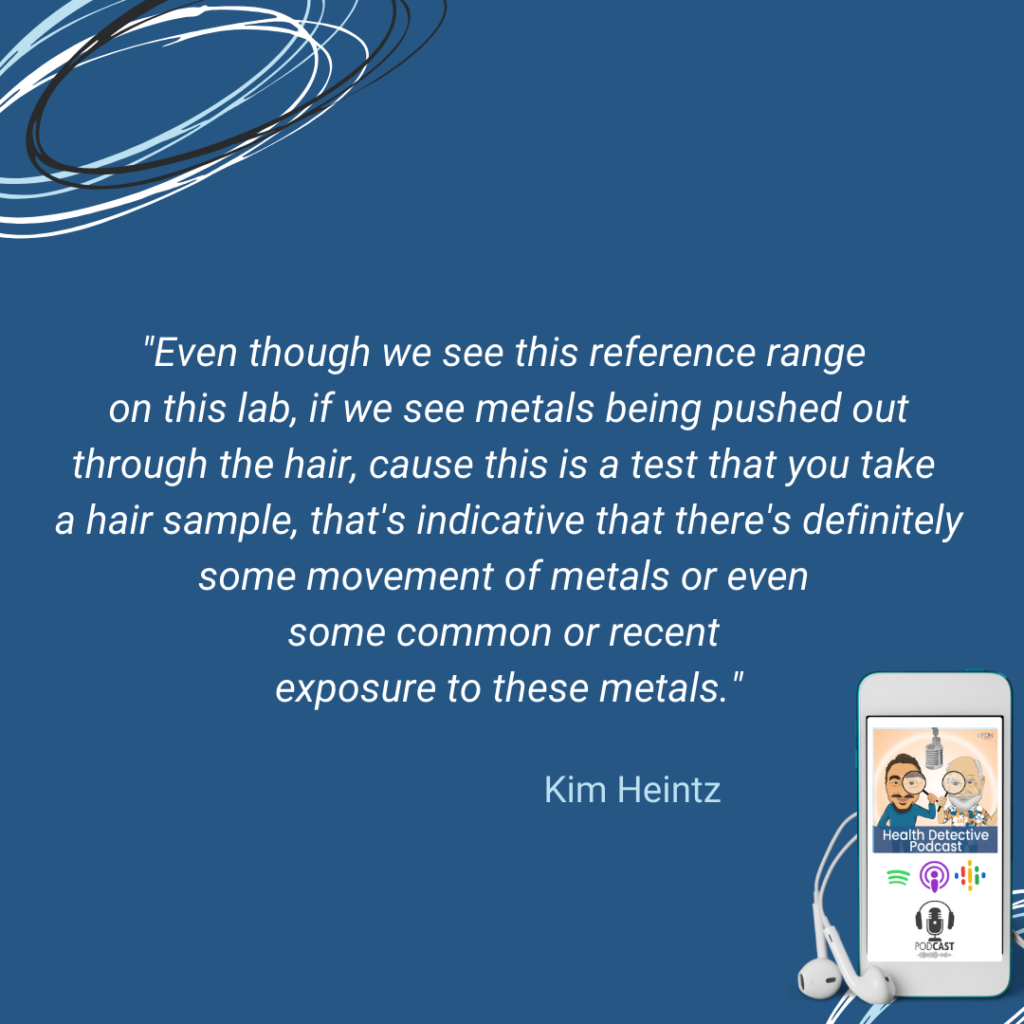
[00:13:42] Kim Heintz: That’s a great question. Even though we see this reference range on this lab, if we see metals being pushed out through the hair, cause this is a test that you take a hair sample, that’s indicative that there’s definitely some movement of metals or even some common or recent exposure to these metals.
So, especially with arsenic being raised like that and Mercury being raised like that, to me, that would say that this person did have a recent exposure to arsenic and mercury or is still being exposed to them on a regular basis.
Reduce Exposures & Change Out Toxic Products
It turned out she was eating a ton of sushi several times a week. As far as the arsenic is concerned, we thought that maybe that came from her breast implants or things like that. She had just had that explant surgery maybe within a year prior to us doing this test.
So, even though when we see some aluminum like that, a lot of us get exposed to aluminum through our cookware, deodorant has aluminum in it and things like that. In that case, even though there’s just a little amount, we’re still seeing some movement in the body, and it can cause problems even in small amounts.
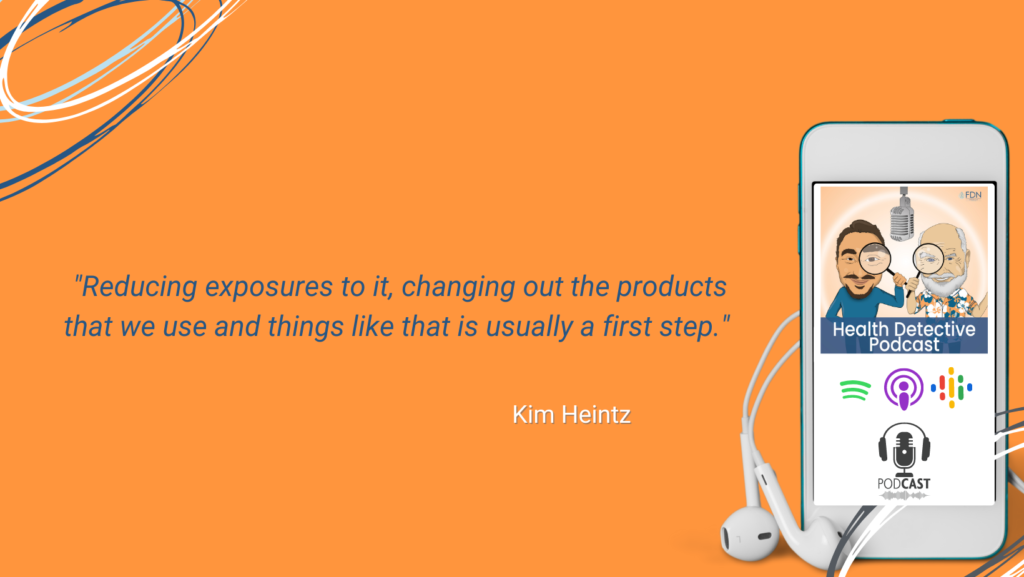
Reducing exposures to it, changing out the products that we use and things like that is usually a first step. The second step is really to balance those minerals. Balancing minerals, those first four macro minerals, is the key to literally everything. Cause a lot of times it’ll help gently pull some of those out.
[00:15:00] Detective Ev: Yeah. I feel like if the cells are getting the things that they need to work better, you would imagine that they’d push this kind of stuff out.
It’s amazing how many people don’t look at this either or don’t even consider it that bad. There was a woman that I worked with, I’m technically still working with her personally, she came to me like, really dedicated person. I mean, almost threw me off with how much stuff she had already done, considering how she felt.
I’m like, all right, this is kind of weird. I know we gotta be missing something here, but you gotta dig kind of deep to find it in those clients. Eventually, we come across this. I’m like, has anyone run any labs with you?
High Toxic Levels Needs Support
She said, yeah, I’ve had this hair, tissue, mineral analysis thing done. I’m like, all right, cool. So, she sends me that one.
You know where that sodium is on the left side here, where it’s like literally higher than the top end, that’s where her Mercury was on the other HTMA test. I said, well, what did they do for you? She said, oh, well I just had to stop eating like fish and this would detox itself over time.

I was like, oh my God. Because this was like a year ago before we ran the test again. And I’m not even saying that’s not literally correct because she was in Costa Rica at the time. She was eating high amounts of seafood right off the pier, basically, from where they were fishing. I’m not saying that’s incorrect. But the idea that we’re not going to support this person in any additional way while they are clearly symptomatic when their mercury is that high, was just asinine to me.
So I said, how about, let’s do this. You run the test again. Cause I know it’s been a year. I know that you don’t want to run it right away again, but I just want to see it. If the mercury’s not high, I’ll pay for your test. And if it was high, then you just say, good idea and we do the supplement stuff together. She said, all right, fine.
We run the test and sure enough, was it down lower than last year? Yeah, it was. It was still the highest mercury I’ve ever seen other than her original one on this test. This stuff doesn’t just magically go away, right? We need to put in a deliberate effort to getting this stuff out.
Balance, Then Detox
In addition to balancing the Big Four, which is going to help this, what are some other things that we might recommend to someone who’s dealing with higher levels of mercury, arsenic, or whatever?
[00:16:54] Kim Heintz: Yeah, there’s specific protocols that we do. Depending on the metal, there’s certain minerals that are really helpful to kind of like have an antagonist relationship to help slowly, gently pull that out.
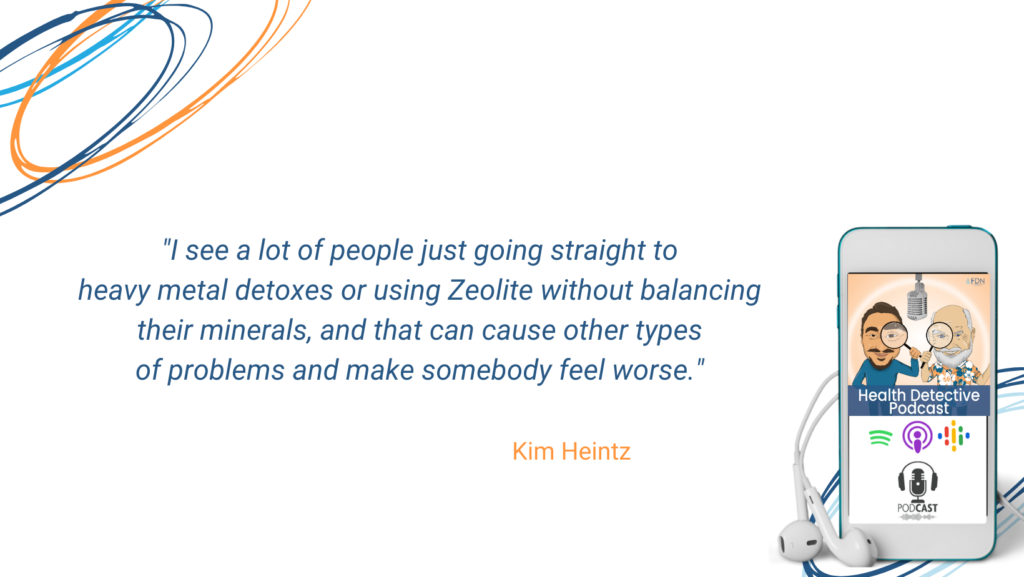
We’ll also do binders. Zeolite spray can be very helpful, but you have to make sure that you’re balancing the minerals first. I see a lot of people just going straight to heavy metal detoxes or using Zeolite without balancing their minerals, and that can cause other types of problems and make somebody feel worse.
Those are usually the starting points from that. Then once somebody’s minerals are a little bit more balanced, meaning that their body can handle more of an aggressive, if you will, detox of a metal, then we can do specific protocols for that metal, especially if it’s still hanging in the tissues like this and it needs a little bit of extra support to get that out.
[00:17:39] Detective Ev: Cool. I don’t know if this applies directly on the HTMA, but I’ve heard that the lower the mercury, not always, I think it’s like more of like a middle ground thing, it could actually be harder to get some of these metals out when they are lower because the body won’t recognize it as easily as when it’s super high.
First of all, do you know what I’m talking about? And assuming that you do, is that relevant on the HTMA? Is it harder to get those last levels out than a higher level?
Moving the Non-Embedded, Elevated Toxic Elements Around
[00:18:01] Kim Heintz: I don’t know if it’s necessarily harder. It’s just, if your minerals are out of balance, it’s going to be harder, and we don’t actually want to do a whole lot with trying to move those metals out of the body at that time.
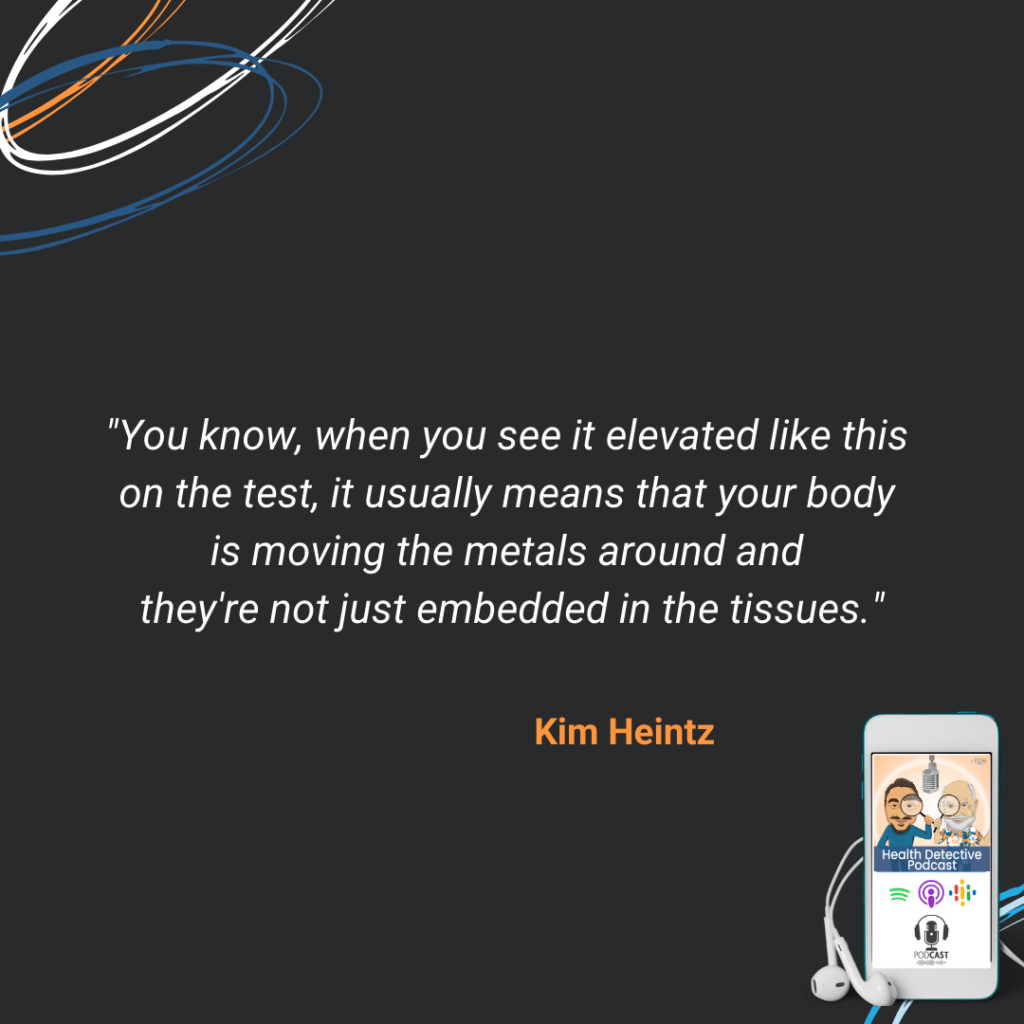
You know, when you see it elevated like this on the test, it usually means that your body is moving the metals around and they’re not just like embedded in the tissues. So, when you have more freedom in your mineral system because it’s working properly, then you should actually see those elevated and it is easier to go after.
When they’re low, yeah. And especially when you’ve got such imbalances in the macro mineral system like we see with this client. You don’t really want to do a whole lot of aggressive work on the metals on this time. Down the road, definitely. But first priority is always balancing those minerals.
[00:18:44] Detective Ev: Very interesting. Well, we’ll move on to the next section in a second.
I actually realized; I apologize. I should have asked you this question probably in the beginning. Why did you end up using this lab in your practice? There’s, of course, nothing wrong with this. We get a bunch of additional labs that we get access to once we graduate FDN. But it’s clearly not one of the core ones taught.
Someone has to really go out of their way to use this and learn this. Must have been for a good reason. So, what motivates you or what have you seen that you started using this in your practice?
Reasons Kim Loves HTMA Tests
[00:19:12] Kim Heintz: I think there’s two core reasons why. First, my own experience. I suspected I had copper toxicity. Cause I had 12 years of birth control, hormonal birth control use, and three years of a copper IUD. I was dealing with a lot of copper toxic symptoms.
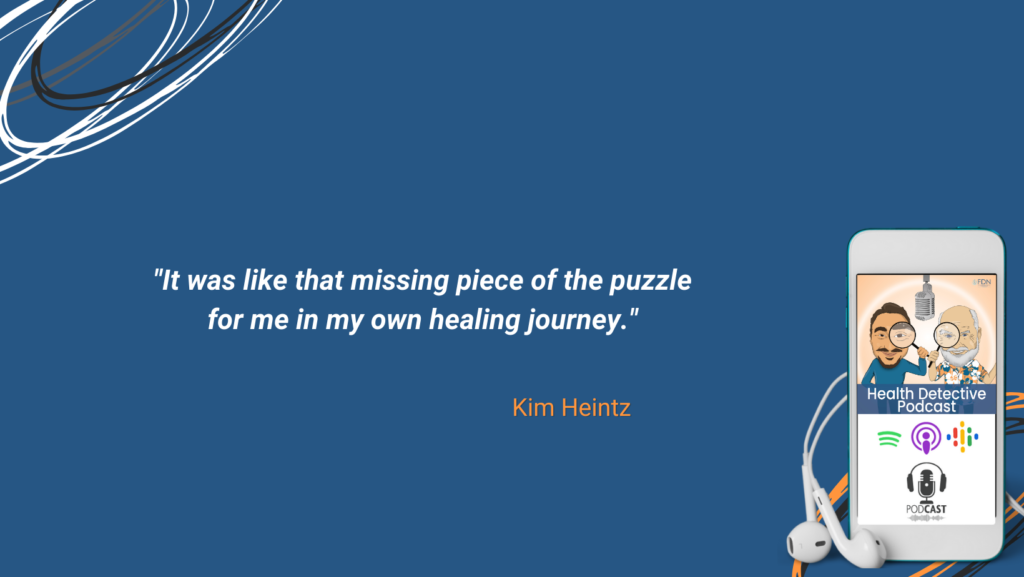
I’d done the FDN approach. I felt pretty darn good, but I still was dealing with some symptoms of copper toxicity. So I decided to run this test and sure enough, I had copper toxicity. It was like that missing piece of the puzzle for me in my own healing journey.
It’s what took me like finally to the finish line as far as like how I felt. I love this test for that reason. I’m pretty passionate about copper toxicity because of my own experience with it. I work with a lot of women who do experience that or have symptoms of it. So, I have found it to be super helpful in my own practice with regards to that. And it’s the most cost-effective functional lab that we have access to.
[00:20:00] Detective Ev: Yeah. I will say that.
That’s one thing that intrigued me is I’m hearing these stories and I’m hearing how effective it can be. Just running this alone sometimes, I’m like, this is cheap. This is really cool if I can help get the needle moving for people.
I will say this, I mean, I’ve been in this space for a very long time. Grant you, yes, I was burning the candle kind of at both ends when I ran this test. But I will say that supplement helped me a lot, like the protocol for this.
Supplementing A Busy, Stressful Lifestyle
And I say supplement, not that we only do that as FDNs. I mean, I already had everything else dialed in and I wasn’t going to back off the work. I just, I didn’t want to do that personally.
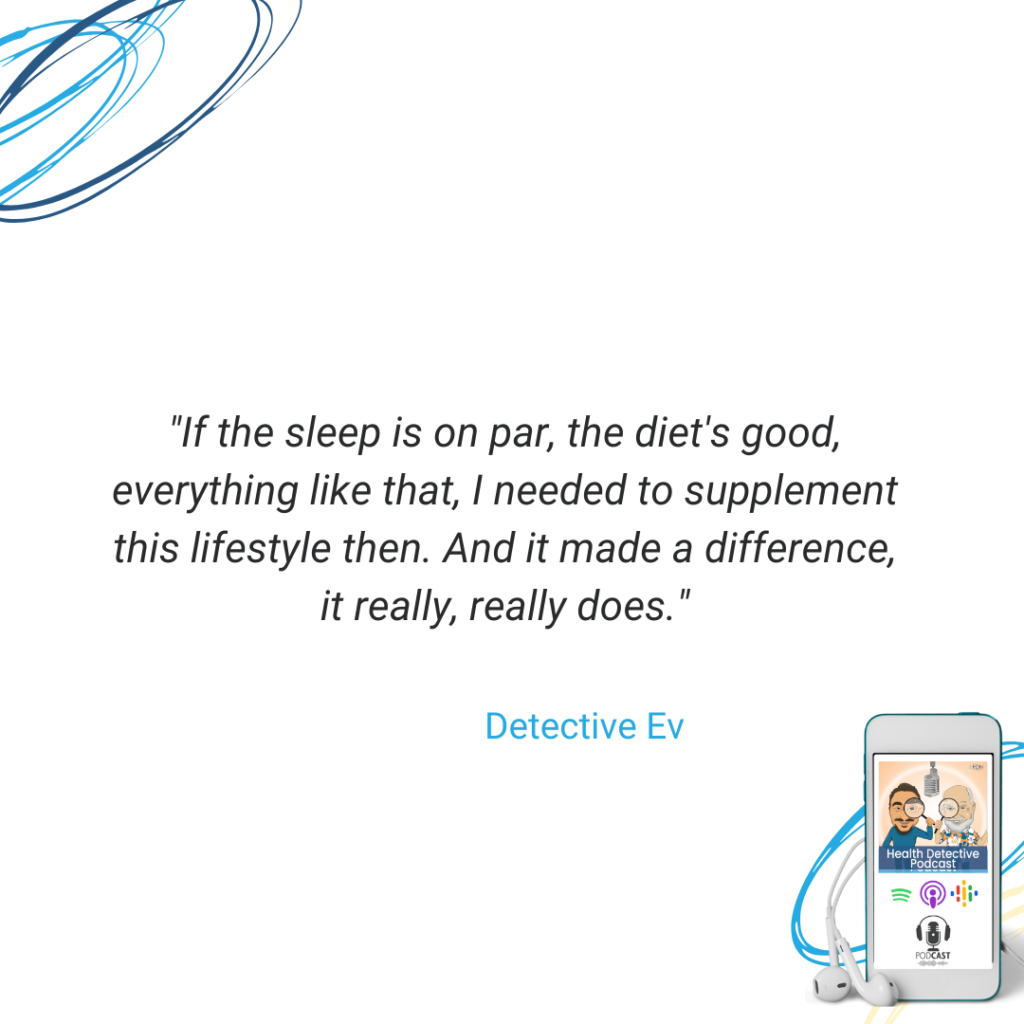
So, there’s only so many things you can do at that point. If the sleep is on par, the diet’s good, everything like that, I needed to supplement this lifestyle then. And it made a difference, it really, really does. It’s very cool. It definitely helps in physical exercise as well.
[00:20:45] Kim Heintz: Oh, yeah. As an athlete, it’s been instrumental for me. I saw my performance just totally take it to the next level because I supported my own system.
So, you were burning the candle at both ends and feeling that stress and that pressure, supporting your minerals is going to help you do that successfully and not feel too burned out.
[00:21:03] Detective Ev: Absolutely.
All right. Moving down to our next section here, the Additional Elements. How do you look at something like this? This is something I’m very ignorant to, this whole section. Do we do anything with this? Do you kind of just ignore it or is it case by case?
[00:21:15] Kim Heintz: It’s case by case. In this case, two of them are, in my opinion, are more like nutritional elements.
Rubidium, which is the most elevated on that section, and then lithium, which is right next to it. Rubidium is very helpful for helping a person get the adequate levels of potassium in. This person’s rubidium and potassium were elevated, so we don’t really have to worry too much about that.
HTMA Tests: Additional Elements
But in the other profile that we’re going to take a look at, you’ll see that both of them are very low. We would want to support both of those cause rubidium and potassium go up and down together. I always look at that.
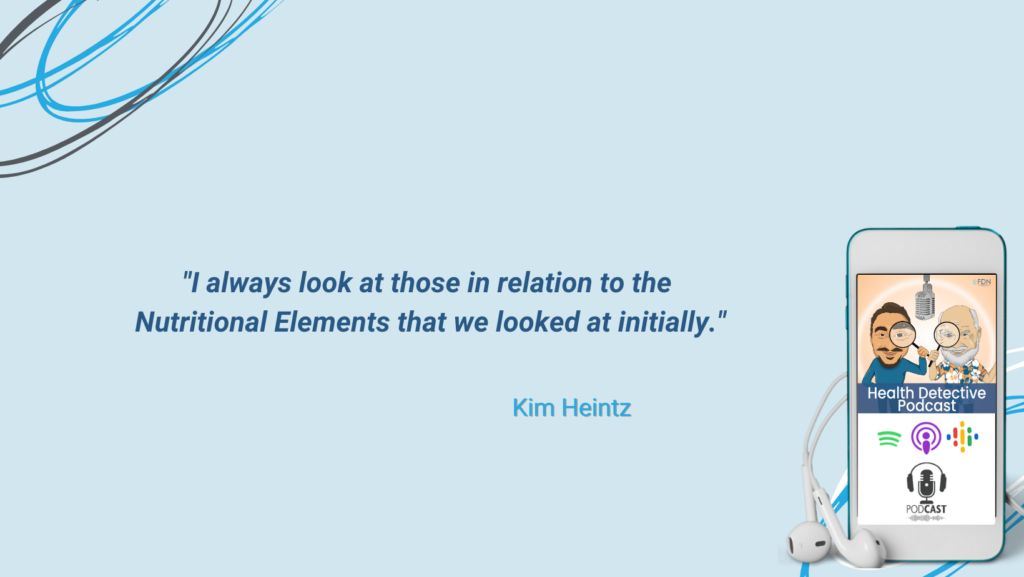
And then lithium can be very helpful for mood related things. Sometimes we’ll do like a very, you know, five milligrams of lithium orate to help if somebody’s lithium levels are low. Can be helpful for detoxification as well. So sometimes depending on, again, looking at the symptom profile of a client, we may do some support with lithium. I always look at those in relation to the Nutritional Elements that we looked at initially.
[00:22:12] Detective Ev: Very cool.
I saw someone where they suffer with what they’re told is bipolar. I say that not because I don’t believe in bipolar, I just don’t know if I believe it for them, but that’s beside the point. They’ve been given, of course, high amounts of lithium throughout the years because of this. It’s an older client.
So, it’s still used, right? But it was just handed out at one point, like this was the go-to for it. It was just again, like where that sodium was for this woman here, it was just off the charts. I’m like, wow, that seems like they’re getting a little too much if it’s that high but could be wrong. Who knows?
All right. We’ll do this first. We’ll do Significant Ratios first. What does this mean? Do you even need this when you know the other things? Or do the ratios have a unique educational purpose for you as the practitioner?
HTMA Tests: Significant Ratios
[00:22:54] Kim Heintz: Ratios are probably just as important or more important than the individual minerals themselves because they tell us unique things about a person’s different systems.
You know, I talked about the calcium/phosphorus ratio, which is the first one that you see there. That tells us our metabolic rate – fast oxidation, slow oxidation, et cetera. Again, if you’re below the midline there, then you’re going to be considered a fast oxidizer. If you’re above it, and I’ve seen it up as high as 12, even higher before, 20 for somebody’s calcium/phosphorous ratio. The higher the number, the slower your metabolism, essentially. That’s something that we always want to take a look at.
The other ratios are also important. The next one there that you’re seeing on the screen is your sodium/potassium ratio, we want to see those two how they’re in relation to each other. That’s our stress/vitality ratio. We consider it one of the most important ratios for somebody.
When somebody’s high, they might be dealing with metals, stress, inflammation. They feel irritable, angry, snappy feelings, high stress feelings. Then when it’s really low, they feel completely exhausted, run down, fatigue, chronically stressed, poor immune system, digestion issues and things like that.
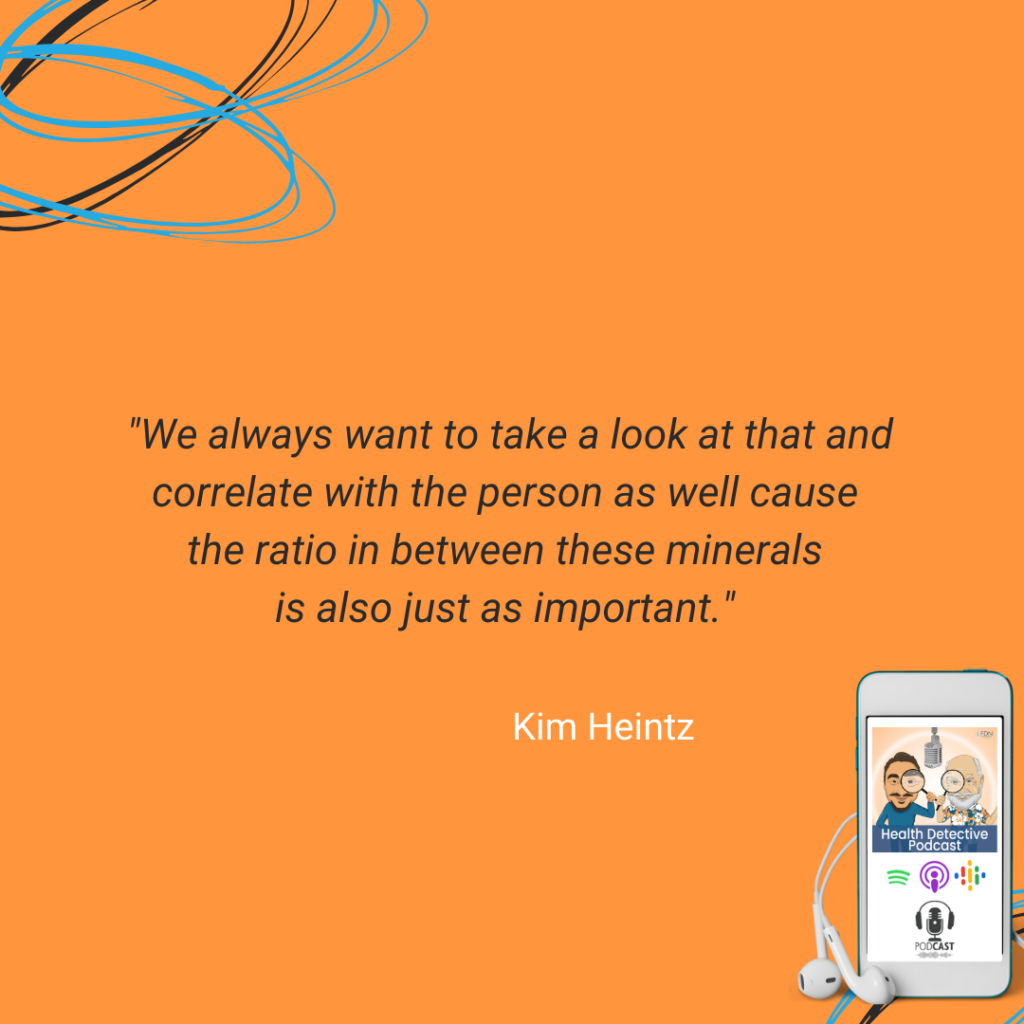
We always want to take a look at that and correlate with the person as well cause the ratio in between these minerals is also just as important.
[00:24:16] Detective Ev: Okay.
[00:24:17] Kim Heintz: A couple other ones there, calcium/potassium ratio, that’s our thyroid ratio. There’s a statistic that like somewhere around one in eight people deals with a thyroid issue at some point in their life, whether or not they know it.
HTMA Tests: Analyzing Thyroid Ratio & Adrenal Ratio
Looking at the thyroid ratio can be very helpful because, like in this person’s case, she had like lower calcium. But a lot of times I see in the slow oxidation rate, like their calcium is super elevated and it’s almost blocking nutrients from getting into the cells. So, blocking thyroid hormone glucose and nutrients and things like that.
Always taking a look at the thyroid ratio is very important to be able to support the body properly.
[00:24:53] Detective Ev: What about the sodium/magnesium one? I feel like that’s probably important.
[00:24:57] Kim Heintz: That’s another really important one. That’s our adrenal ratio. I always like to look at that as well.
When somebody has a high sodium/magnesium ratio, like we see in this particular example, a lot of times, we’re dealing with elevated inflammation in the body. But they also might have that wired and tired feeling because they’ve got excessive adrenal. They tend to have like magnesium deficiency. That’s pretty common in this particular ratio when it’s elevated.
Now when it’s low, somebody’s dealing with chronic stress, exhaustion, decreased adrenal effect. They’re just feeling super tired. Having a hard time getting out of bed in the morning, feeling run down and exhausted all day long.
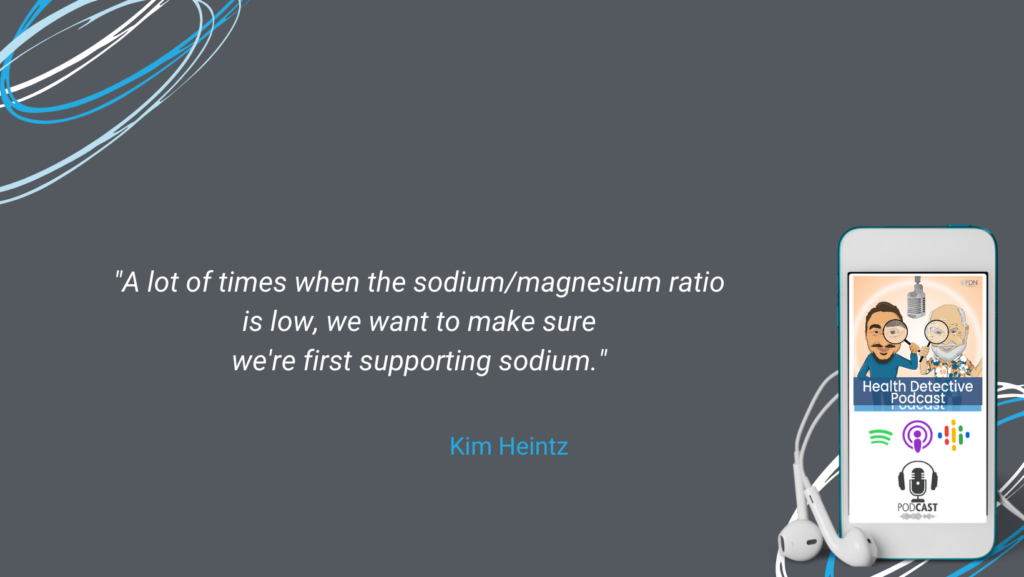
A lot of times when the sodium/magnesium ratio is low, we want to make sure we’re first supporting sodium. A lot of times people make themselves feel worse because they keep hearing magnesium, magnesium, magnesium. But they also need sodium to help support those adrenals cause the sodium really nourishes the adrenals.
Ratios Help Prioritize What Needs to Get in First
Looking at that, sometimes it helps us prioritize what do we need to get in first.
A lot of times with somebody with a low sodium/magnesium ratio, I might be like, okay, start your morning with a glass of water with a pinch of sea salt in it maybe with a little bit of lemon and really start to get their sodium levels restored. Then we can start to layer in magnesium down the road.
[00:26:12] Detective Ev: That’s such a good point.
I mean, how often, everywhere the magnesium thing is pushed? I do hear people talking about taking some salt, but it’s niche. It’s in our world of functional medicine. Whereas the magnesium thing is pushed to every single person I know, even if they don’t know anything about health.
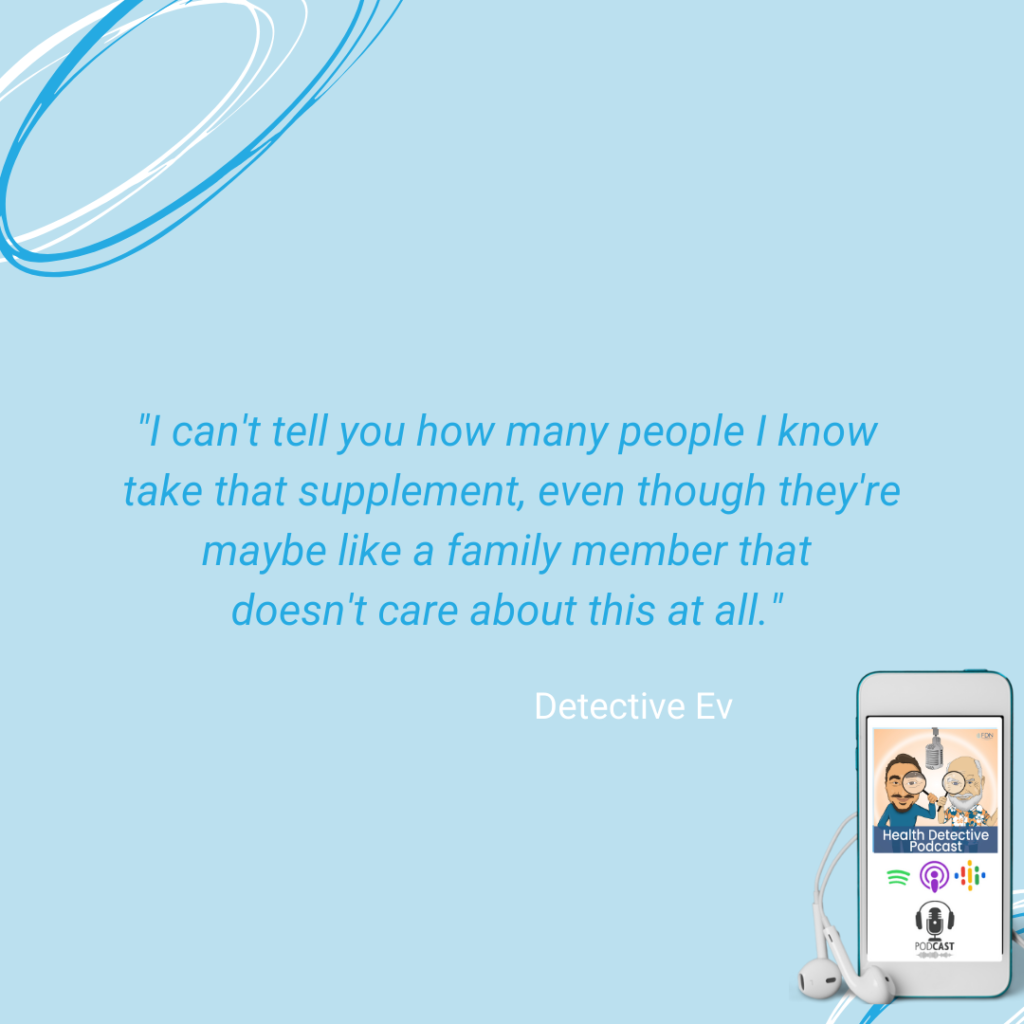
I can’t tell you how many people I know take that supplement, even though they’re maybe like a family member that doesn’t care about this at all. Right? They drink beer every night and yet they’ll take magnesium because they’ve been told to. Very interesting.
Is this the next section here that you were talking about has unique markers? Cause I feel like when I’ve looked at these other tests, I don’t recognize this Toxic Ratios thing unless I’m just really that new that I don’t know it.
[00:26:46] Kim Heintz: This isn’t on the other test that you’re familiar with. But really what this shows us is just the interference of metals with some of our core minerals. The goal is we want the bars in this section to be all the way at the top.
So, for her, we’re showing that we have a significant interference of metals in her mineral profile. You see the first one that’s lower is iron and lead.
HTMA Tests: Toxic Ratios
Iron might be getting interfered with, because of lead.
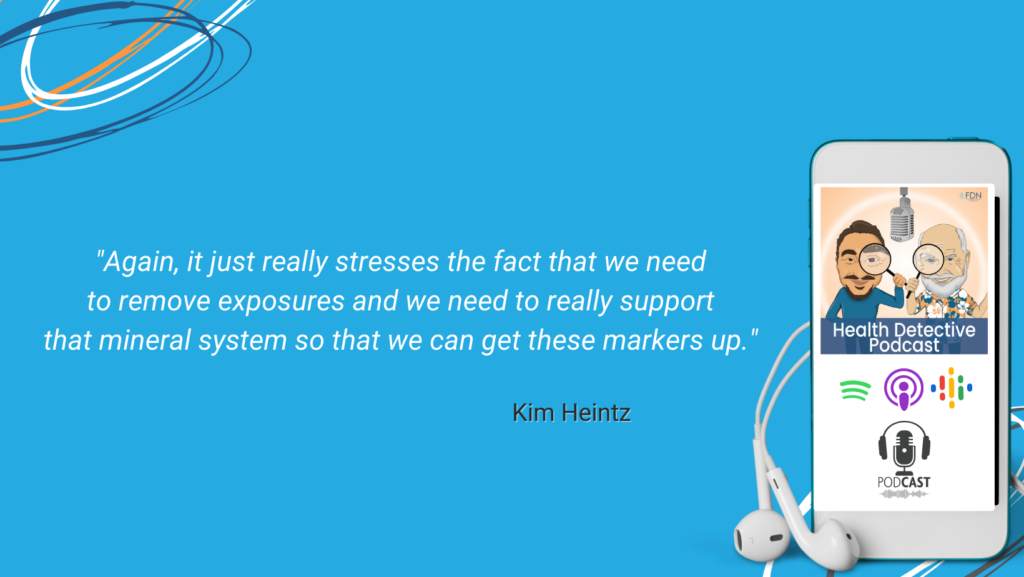
A lot of them are being interfered with because of mercury. Iron, selenium, zinc, and sulfur are all showing some interference because of that. Again, it just really stresses the fact that we need to remove exposures and we need to really support that mineral system so that we can get these markers up.
This is the first test I ran with this client, and I am happy to say that on her third test, which is the most recent one we ran a couple months ago, we were able to get those toxic ratios all the way back to the top. So, we did do some great improvements with her.
[00:27:42] Detective Ev: Awesome!
Man, I’m going to have to go back to eighth grade science class too. My periodic table, you know what I mean. I was good. Listen, I could do the potassium thing, like I remember, K. I knew they tried to screw you up with that when you were in school. But yeah, some of these are getting me a little bit, so I will have to review some of those.
Are these Additional Ratios, the unique markers on this test? I guess I’m still kind of confused which ones were unique that makes you run this test over the other one.
[00:28:03] Kim Heintz: There’s more metals that are tested. There are more nutritional elements that are tested. For example, like boron is not run by Analytical Research, and that’s the other lab. Knowing the status of boron is very helpful because it tells us if we need to support that in order to get the magnesium levels up, stuff like that. That’s why I like to run this test.
HTMA Tests: Additional Ratios
[00:28:22] Detective Ev: Cool. Do you look at this Additional Ratios section, which is at the very bottom or no?

[00:28:27] Kim Heintz: Sometimes I do, but there’s not a whole lot of explanation with regards to that.
[00:28:31] Detective Ev: Okay. All right. Well thank you very much. And I’m so glad to know that this person is starting to feel better. That’s what it takes. I noticed that you said that was a few months ago and this original test was ran on May 11th, 2021. I think this matters.
FDN works. What we do works, right. But this can take some time. And I’m sure there’s many things that come up with a particular client throughout a year plus of working with them. But you know, trust the process.
This person is 43 years old, right? Your body, you have to remember, unfortunately, after your late twenties, early thirties, the body, even if everything was being done perfectly, it is degrading, not increasing, right? We’re fighting against time here a little bit too. That needs to be noted.
But you can heal, you can get better. You just gotta give the body some time. That’s amazing to know that things are getting better for her. I’m very happy about that.
For time’s sake, we can skip a lot of the formalities on this one. That’s good because we kind of went over some basic stuff. Let’s get right into this one. We have a slow oxidizer pattern, 39-year-old female. Similar enough age. And this was run in April of 2022.
HTMA Tests: High Calcium/Calcium Shell
Right from the get-go, for those on audio, we’re seeing a completely different thing on the first part in the nutritional element. So, thank you so much, Kim, for bringing on something, again, wildly different than the other one. We have super high calcium, middle range magnesium, and then low sodium, low potassium. This is a slow oxidizer pattern as it says, correct?
[00:29:45] Kim Heintz: Yep, that’s correct. That’s our typical slow oxidizer pattern.
[00:29:49] Detective Ev: Is this what they call the calcium shell with it being so high?
[00:29:52] Kim Heintz: Exactly. You’re on it.
Yeah, anything above like 165 on the calcium. Calcium, we want to be around 63. This person’s calcium is 259 for those of you who are on audio. That’s pretty significant. We’ve got this calcium that is building up in the tissues.
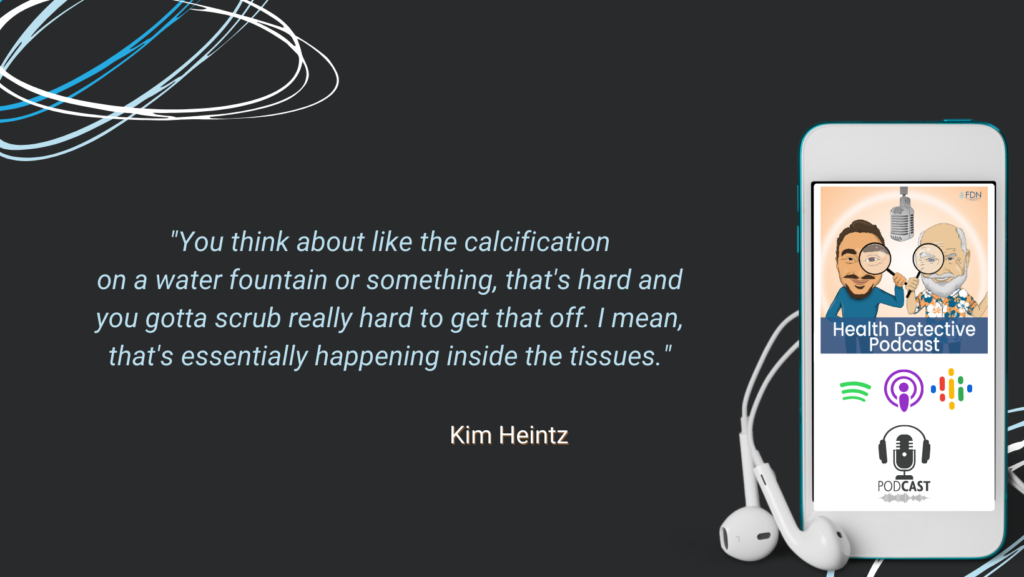
If you think of calcium, calcium is a hard substance, right? You think about like the calcification on a water fountain or something, that’s hard and you gotta scrub really hard to get that off. I mean, that’s essentially happening inside the tissues.
What that also means is that it’s not getting into the bone. We do see when somebody’s got an elevated calcium profile like this that they could deal, longer term, like osteoporosis, osteopenia and things like that as well. Cause again, calcium’s just not getting to where it needs to be.
[00:30:39] Detective Ev: With this calcium shell thing, I mean obviously it just seems like it’s super high calcium. I know everyone’s different, but is there a typical symptom profile that one might expect to see with someone who has this with the calcium shell?
Symptom Profile of Someone with a Calcium Shell
[00:30:51] Kim Heintz: Yeah, absolutely. A lot of times we’ll see like hypothyroid symptoms. We’ll see irritability. Fatigue is huge because again, if you think about what I talked about earlier with the thyroid ratio where calcium’s kind of blocking nutrients from getting inside the cell. The way that I visually like to explain it is like, it’s almost like the cell is starving because calcium’s blocking those nutrients to get inside that cell, right?
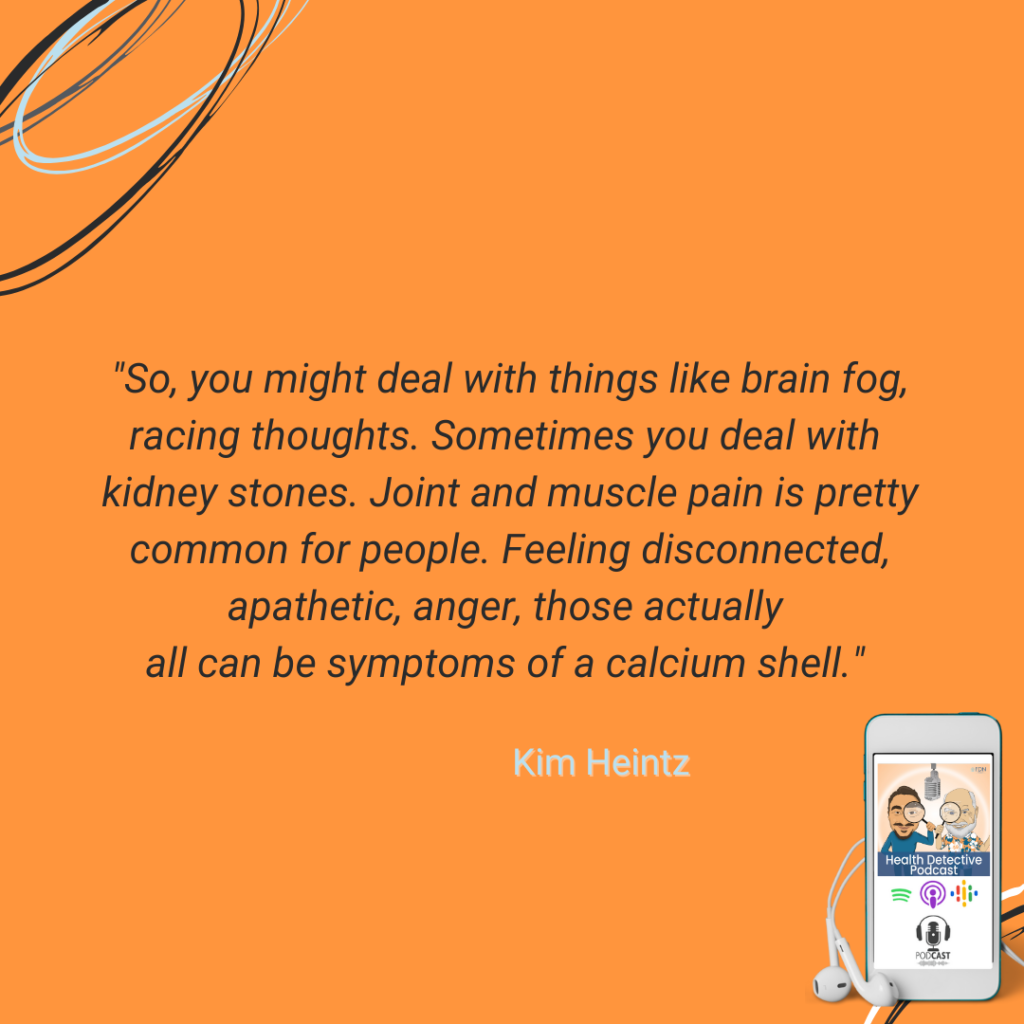
So, you might deal with things like brain fog, racing thoughts. Sometimes you deal with like kidney stones. Joint and muscle pain is pretty common for people. Feeling disconnected, apathetic, anger, those actually all can be symptoms of a calcium shell.
[00:31:28] Detective Ev: Wow. I always hear people talking about, with ketosis and fasting and stuff and even certain other things where if you don’t supplement the electrolytes or you’re dehydrated all the time, it can lead to the kidney stones. Is that correlated at all here or is that a completely separate causal thing for kidney stones?
[00:31:45] Kim Heintz: I think there’s a couple different kind. I’m not a hundred percent sure and I haven’t really worked with a lot of people with that, so it’s hard for me to answer that specifically.
[00:31:52] Detective Ev: No problem at all. I was just kind of curious. I like trying to connect these things if I can.
We see kind of, in my opinion, correct me if I’m wrong, please, but a conceptually similar thing in the other Nutritional Elements on this thing outside of the Big Four, whereas like, all right, yes, some are high, some are low.
HTMA Tests: Supporting Selenium and Molybdenum
I mean, they’re basically within the reference range. And we would probably expect these to become a little more regulated as we did the Big Four.
I am noticing that the boron seems to be a little higher on this one, a little upper end of the reference range, but it is still within it. So, is this one of those cases where we’re looking at these other nutritional elements and saying, all right, cool, what we need to do here really is just focus on the Big Four, or is there something that you would’ve done or did do for this person and these other ones?
[00:32:29] Kim Heintz: Yeah, we definitely want to make sure we’re supporting the Big Four a lot. I mean, you see that potassium, it’s super low. Low potassium, a lot of people deal with like heart palpitations, exercise intolerance and things like that when we see sodium that low. Same thing with sodium and potassium, that low.
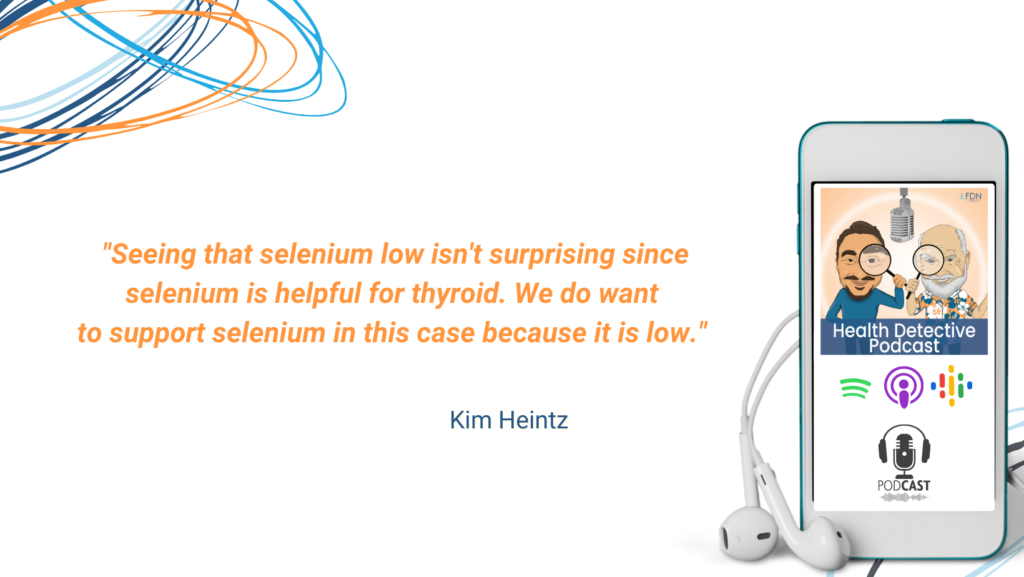
You see her selenium is pretty low as well. I talked about how we see a lot of stuff with like, hypothyroid, hypothyroid symptoms when we see a calcium shell. Seeing that selenium low isn’t surprising since selenium is helpful for thyroid. We do want to support selenium in this case because it is low.
I probably would’ve supported, I think I supported Molybdenum a little bit too, since her Molybdenum was a little bit low. I’m looking at how do we kind of support the whole system as a whole with regards to that.
[00:33:10] Detective Ev: All right. Now this is interesting over here, moving to the Toxic Elements on this one. Again, I’m not an expert in HTMA.
Balancing Minerals Energetically Increases Ability of the Cells
I’ve looked at a good handful of them, though. Some, of course, you see the metals are not terrible, but they’re there. I mean, she’s practically non-existent and I’m kind of surprised by that cause I feel like we’re all exposed to it.
Her Big Four clearly indicates that she is someone who is not doing so great right now, overall. Does this happen often, that these people don’t show up for any metals? How would someone even escape that in today’s world?
[00:33:40] Kim Heintz: Yeah, and it doesn’t mean that she doesn’t have any metals. It just means that her body is not moving the metals out of the body.
[00:33:46] Detective Ev: Oh wait. I got a gold star for this hopefully. Is the reason that they’re not moving it outta the body because she is in a slow oxidizing state right now, so it’s kind of holding onto the stuff?
Kim Heintz: Yes, exactly.
Detective Ev: All right, nice. I’ll take my gold star, please.
Kim Heintz: You got it.
Detective Ev: All right. So, we have no idea how toxic she is really.
[00:34:01] Kim Heintz: Right, exactly.
In this case, there’s not like a whole lot for us to do as far as removing exposures. I mean, there’s a little bit of movement. You do see just a smidge of a line with aluminum and mercury and uranium.
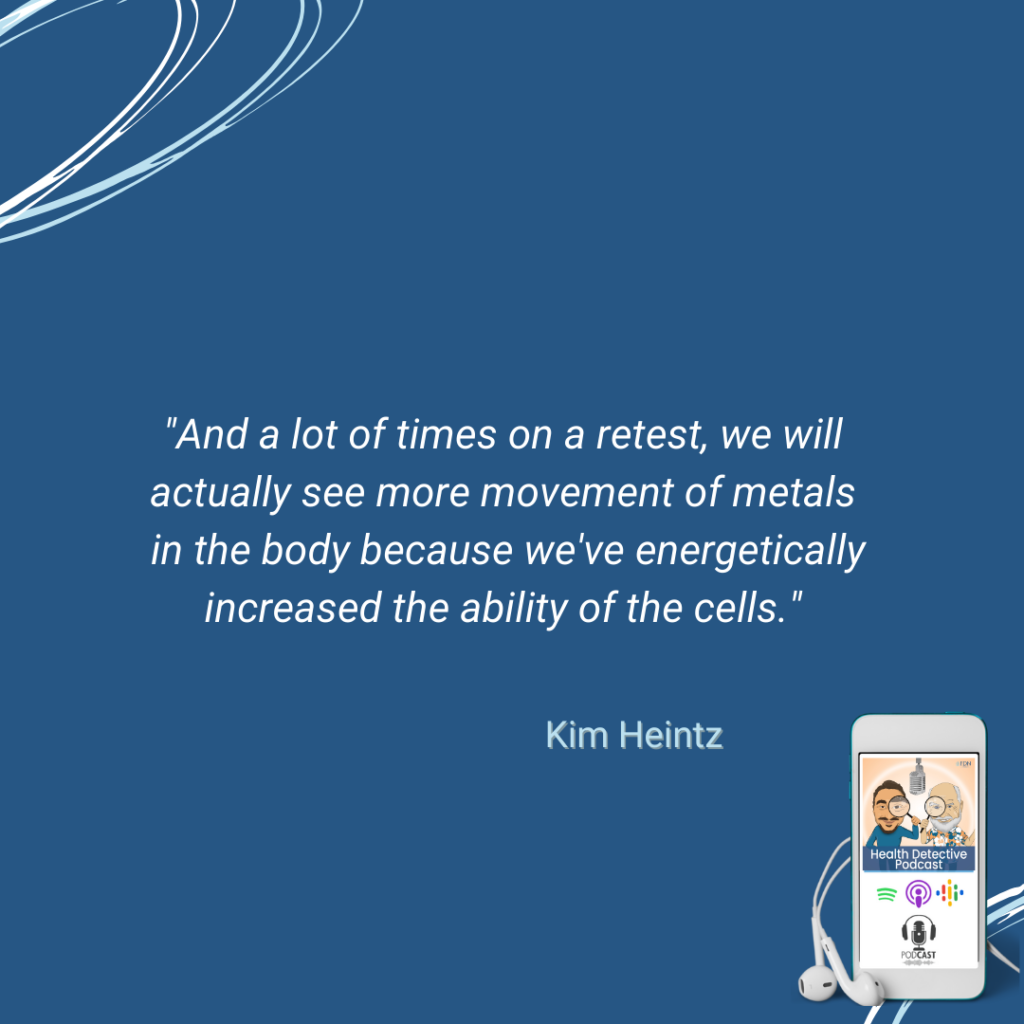
But our real primary goal here is to help break up that calcium and get the sodium and the potassium up so we can get more in a balanced state. And a lot of times on a retest, we will actually see more movement of metals in the body because we’ve energetically increased the ability of the cells.
Sometimes Toxic Elements Go Up, Sometimes They Go Down
[00:34:31] Detective Ev: That is a perfect example of what we do at FDN, right?
Because if you just looked at these as individual tests, the untrained eye would easily say, well, you have metals. That’s terrible. Right? Where we know if you’re working with the client, if you’re actually addressing the person and not just treating paperwork, that’s progress in her case to be getting some of these metals moving.
I know that we don’t know where it would be, but just so I understand this fully, it is fair to say that if we adjusted the Big Four, if we could wave a magic wand and all of a sudden, they were good to go, it is fair to say that the uranium, mercury and aluminum, which we do see borderline, at the very least, those are going up, probably, right?
[00:35:09] Kim Heintz: Possibly, yeah. It really depends on the person.
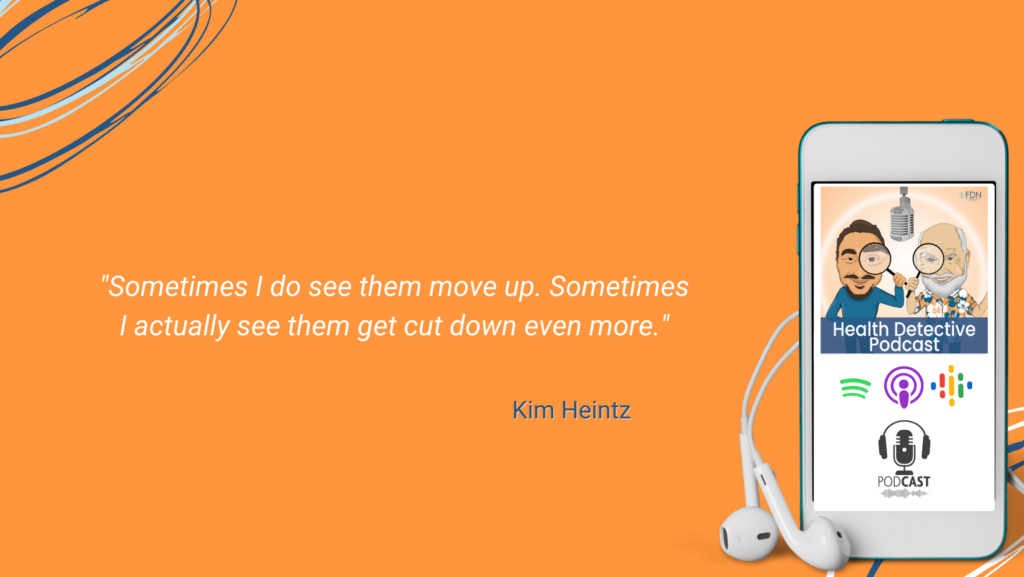
Sometimes I do see them move up. Sometimes I actually see them get cut down even more. It just kind of depends on sometimes balancing those minerals was the key to moving out any of the metals that we were seeing.
[00:35:24] Detective Ev: Very cool.
I don’t know if that ended up being the case for her. This was in April. Do you remember what happened next?
[00:35:29] Kim Heintz: We have not yet retested. That’s coming up here pretty soon, so TBD.
[00:35:33] Detective Ev: All right. No worries.
Next is the Additional Element section again. I could be wrong. Sorry, there’s a lot of markers here. I almost feel like this looks similar to the other one or am I off?
Comparing HTMA Tests Results
[00:35:41] Kim Heintz: It looks pretty similar. We see a little bit of barium; we see some strontium. Usually, we do see strontium elevated when calcium’s high. That’s typically, especially on a first test, that’s what we see.
Barium, there is a little bit of barium, so again, that would be similar to what we saw in the other test. You just want to cut back exposure to anything where you might be getting some barium into your world.
[00:36:01] Detective Ev: Got it. I forgot it was the rubidium that was high. I think what it was is that there was basically one outstanding thing on each side, and that’s what I’m confusing it with.
All right, cool. We see in her ratios; I feel like definitely looks kind of similar even though it’s a slow oxidizer though.
[00:36:17] Kim Heintz: Yeah. I mean, we’re definitely seeing the calcium/phosphorus ratio elevated. Before, I think it was like a one point something, and on this one it’s 14.39.
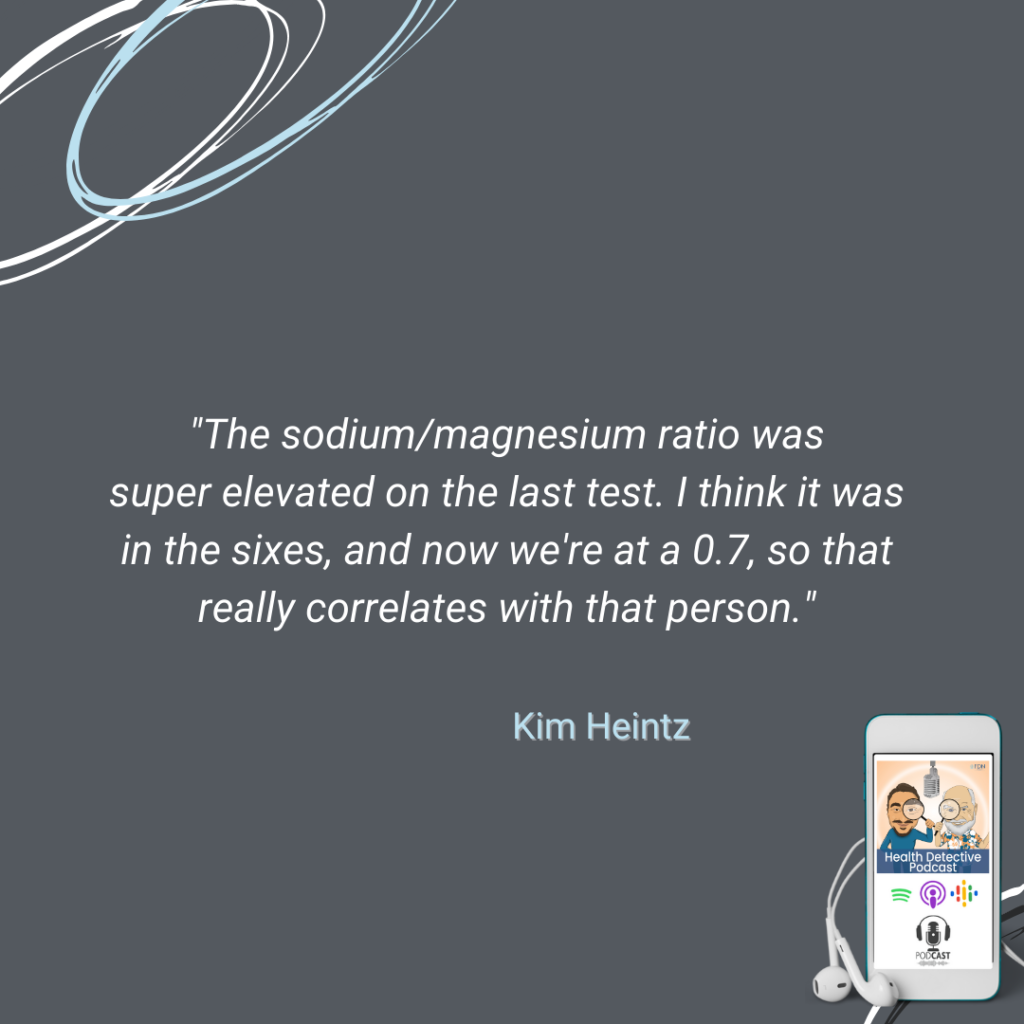
Really quite a slow oxidation rate because again, the calcium’s so high. The sodium/magnesium ratio was super elevated on the last test. I think it was in the sixes, and now we’re at a 0.7, so that really correlates with that person. That person, the sodium/magnesium, this person would definitely benefit from prioritizing sodium over magnesium initially. And then we can layer in that magnesium.
[00:36:46] Detective Ev: Got it. Last but not least here, her Toxic Ratio thing, we wanted them to be at the top of the chart as you taught me. They’re perfect. But is this one of those cases where it’s almost like a non-clue because we know that that metals thing is not necessarily accurate? Or would you still say that this has some validity?
Invitation for Retests & Kim’s Story
[00:37:02] Kim Heintz: I mean, there’s not much to do with it in this case, just this first test around. I mean, really the primary goals of this particular test are to balance those minerals and break up that calcium shell.
I think there was enough there for us to get started with. Then let’s take a look at the Toxic Ratios on a retest.
[00:37:20] Detective Ev: Very cool. Well, we’ll be excited to hear about that retest. If you’d like, please, we have a lot of people that listen regularly. We can kind of see that in the stats.
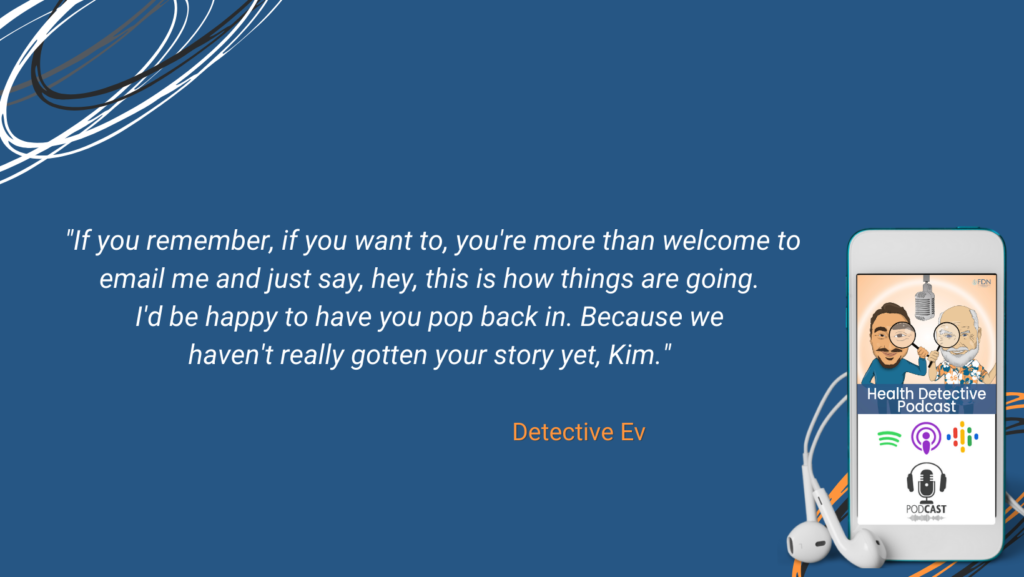
If you remember, if you want to, you’re more than welcome to email me and just say, hey, this is how things are going. I’d be happy to have you pop back in. Because we haven’t really gotten your story yet, Kim.
It would be kind of cool if we ended up doing another episode where maybe there’s some insight to be gained by learning about that retest, then we could actually hear your story as well and just kind of spend a little bit of time on the retest. So, up to you. I hope to hear from you with that.
Now, with this all said as we kind of reach the end of our time, the last question about the test is, I’m hearing from some FDNs, and it’s less than not. But some of these people are just running this test to start off, they’re not running the FDN foundationals. I don’t know. I haven’t done this yet. I would have to imagine that’s not optimal, but I get why they do it. It’s cheaper. I understand this.
HTMA Tests Supplements & D.R.E.S.S.
When you are running these tests, of course we have the ability to supplement. If the person changed nothing but just supplemented, I assume they’d be better off than not. But how much of these numbers really moving, like this stuff really getting in the right direction, how much of it is based on the lifestyle stuff versus these specific protocols and supplements that can come from the test results?
[00:38:33] Kim Heintz: It’s definitely important to do both because minerals are very responsive to stress. So, if you’re super stressed out and you’re not changing your diet and you’re still eating a lot of processed foods, which our food is where we get our minerals from, and stuff like that, you may not see a lot of movement.
I have done retests where somebody was just like, well, I’m just going to do the supplements and I’m not going to worry about anything else cause I just don’t have time for it. Their retest really didn’t show a ton of change. That’s when we have to have that conversation. Like, hey, at least you didn’t get more depleted. Right?
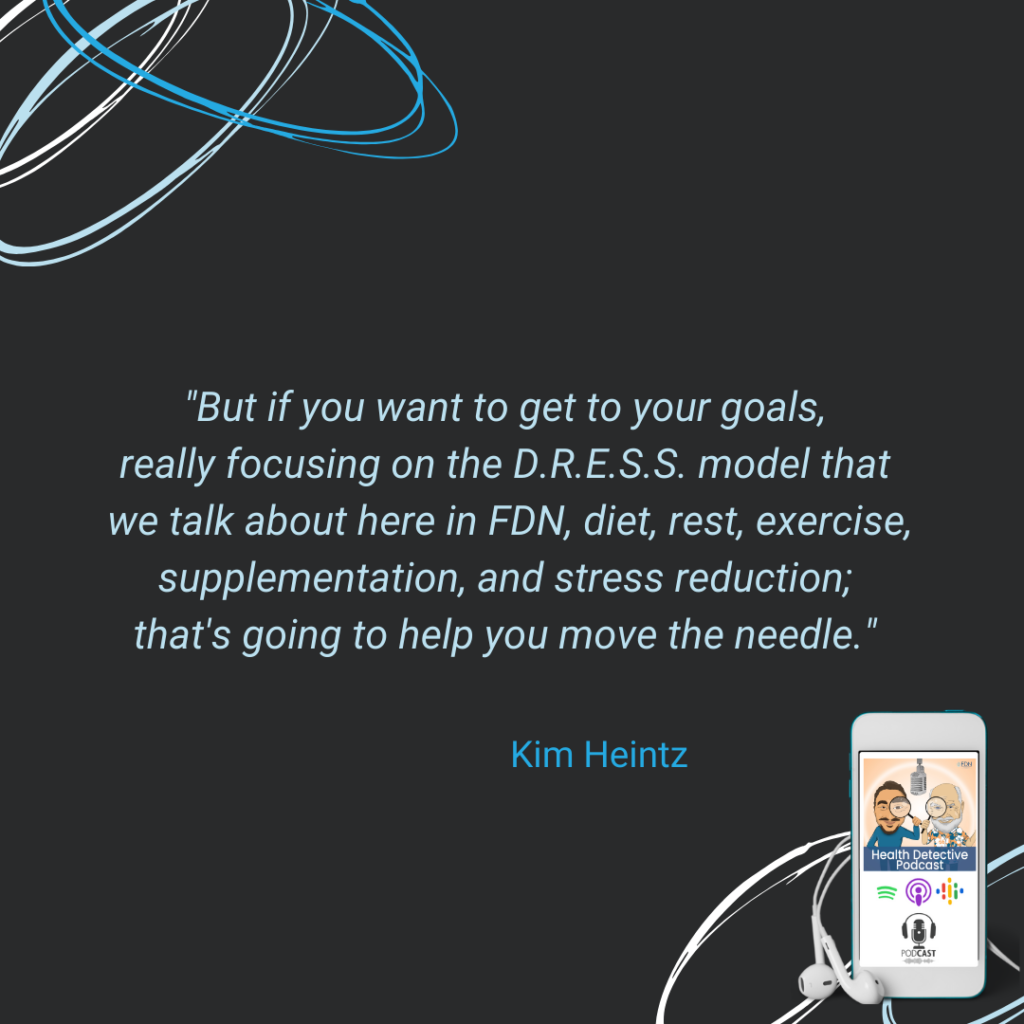
The supplements probably did help with regards to that. But if you want to get to your goals, really focusing on the D.R.E.S.S. model that we talk about here in FDN, diet, rest, exercise, supplementation, and stress reduction; that’s going to help you move the needle. That’s where I see the biggest results.
Even if this is the only test somebody runs, we can see a lot of movement and get some progress if somebody does commit to doing all of the lifestyle strategies, diet, et cetera, too.
Where to Find Kim Heintz
[00:39:31] Detective Ev: Very cool. All right, well I think that’ll just about do it for today.
Of course, I’m going to ask where people can find you. Before we even do that, I think the one question I’ll ask is like, who do you work with? Now, I only have two lab results here, but based on the fact that they’re 39- and 43-year-old females, I’m guessing, is it like that earlier middle-aged woman that you typically help? What type of person typically comes to you?
[00:39:51] Kim Heintz: Most of my clients are women between 30 and 50. I do work with men too. I just primarily have women coming to me. I think just maybe cause that’s who I am. But I work with people who are more, I’m 41, so it’s in the same general age range as myself.
I work with a lot of people who are dealing with gut issues, migraines. I had chronic migraines for 25 years, and so I get a lot of folks who experience chronic migraines themselves. Then also copper toxicity since it’s something that is pretty near and dear to my own personal experience as well.
[00:40:24] Detective Ev: All right. Where can people find you if they’d like to work with you and have their HTMA or other things analyzed?

[00:40:29] Kim Heintz: A good way to get a hold of me or find me is on Instagram. I’m really active there and it’s just my first name dot last name. So, Kim.Heintz is my IG handle.
Kimheintz.com is my website and I do have an HTMA sales page, et cetera, to learn more about the HTMA and stuff. And that’s kimheintz.com/HTMA. Pretty easy to find.
Conclusion
[00:40:51] Detective Ev: Well, thank you so much for coming on with us today. I appreciated this and I love learning about these new tests by my fellow FDNs, so thank you.
[00:40:57] Kim Heintz: Yeah, it was fun geeking out with you over here today. I love the HTMA, so thanks for having me.
You are always welcome to visit us at functionaldiagnosticnutrition.com.
To hire a coach, go to fdnthrive.com.
For a FREE Health Review, go to fdnthrive.com/match/.

